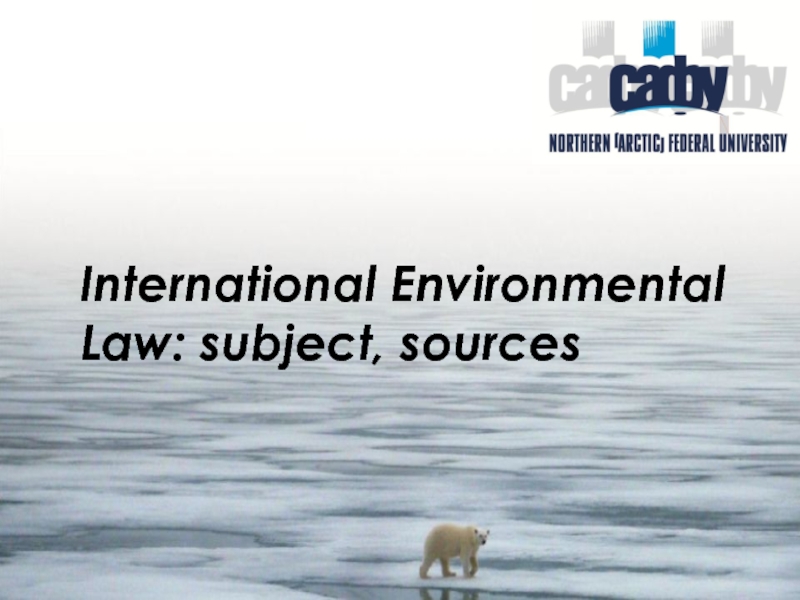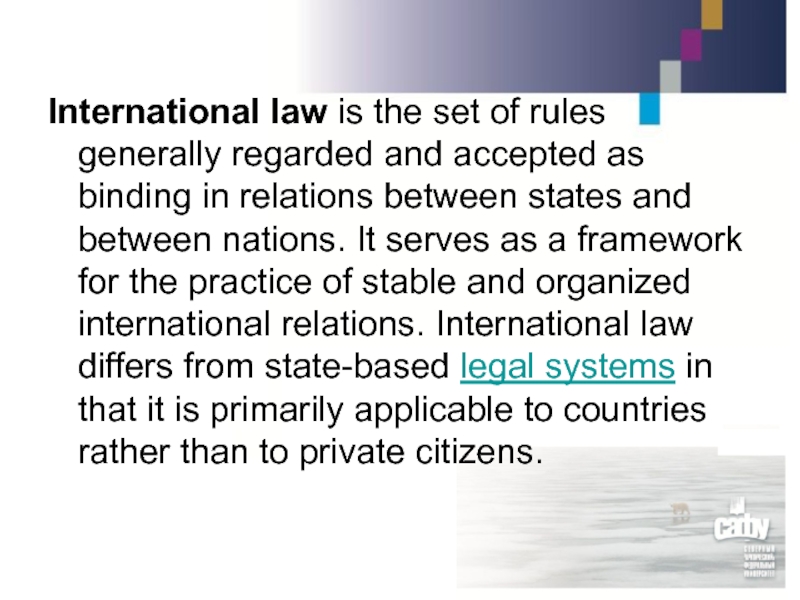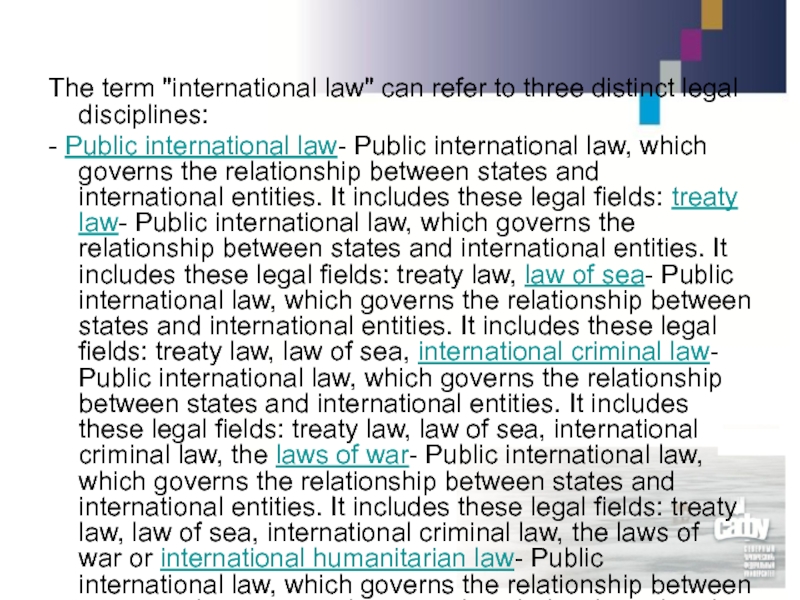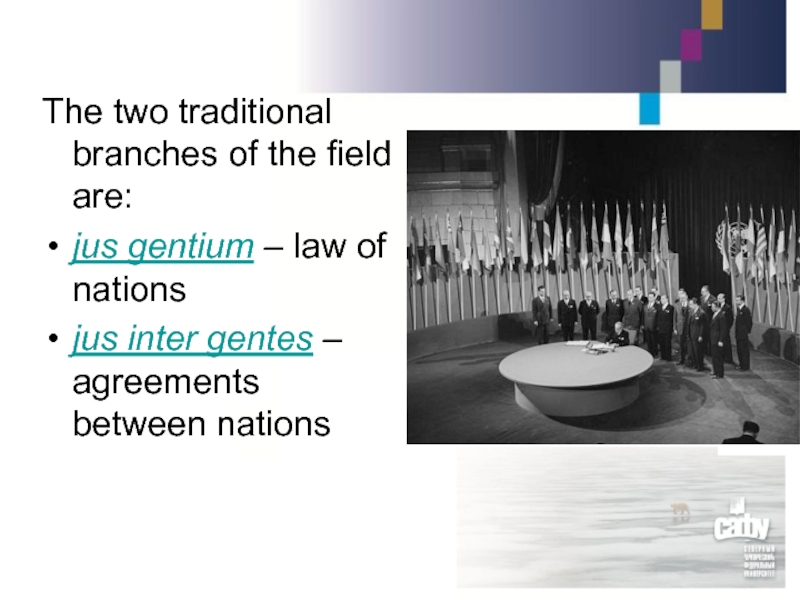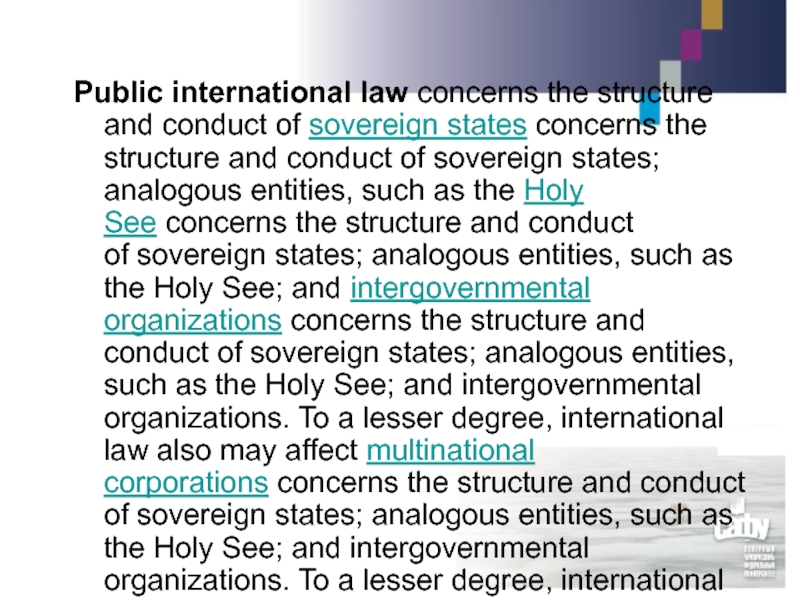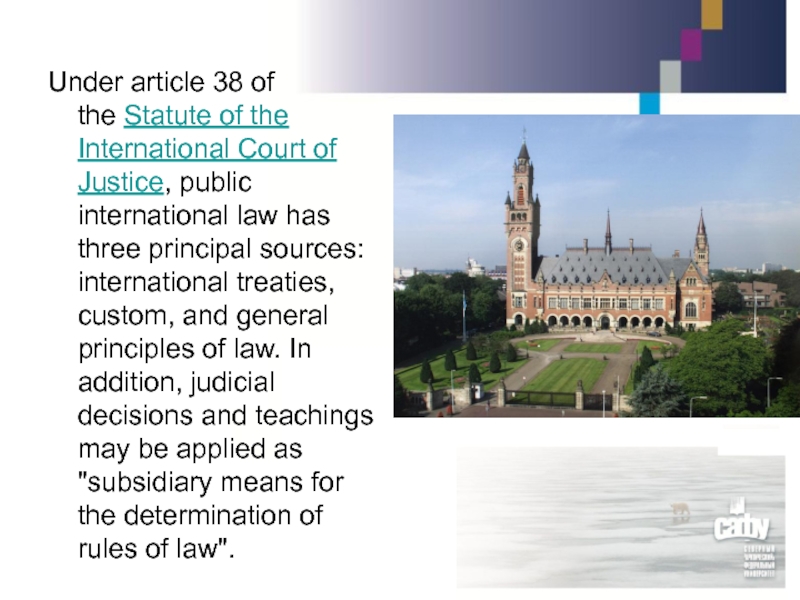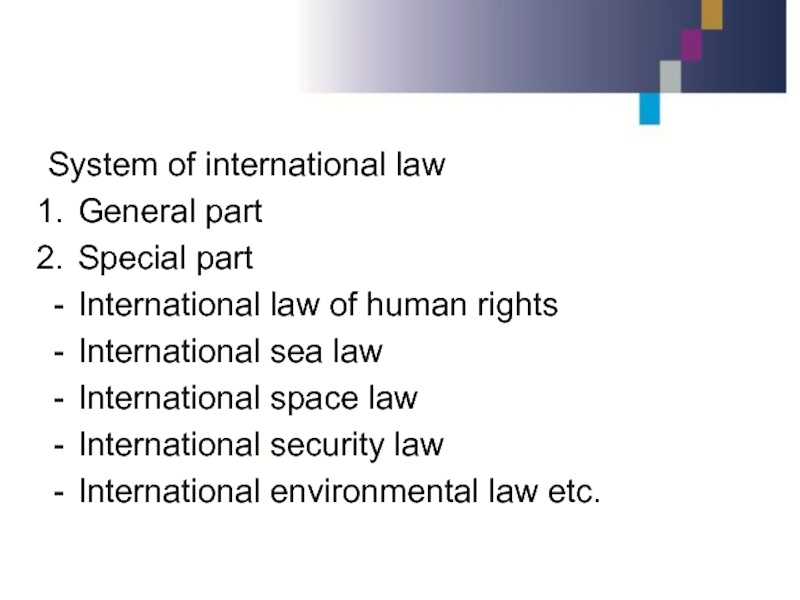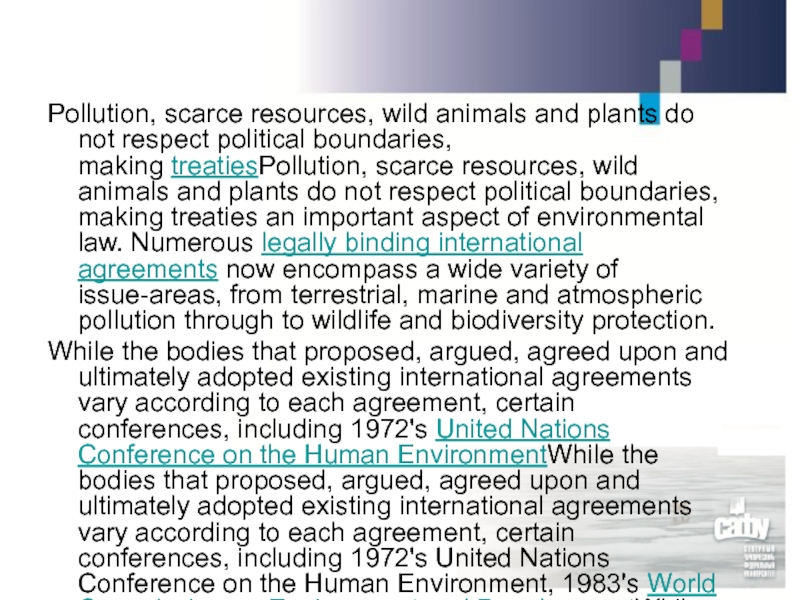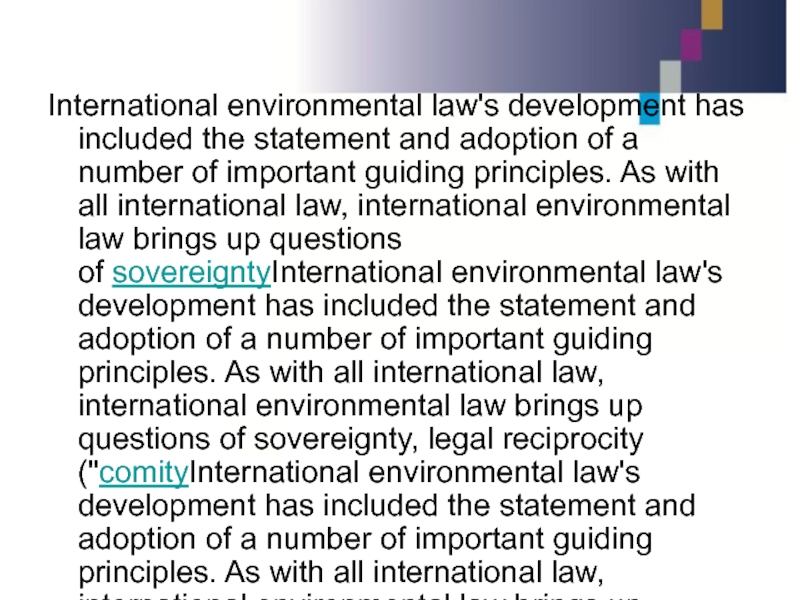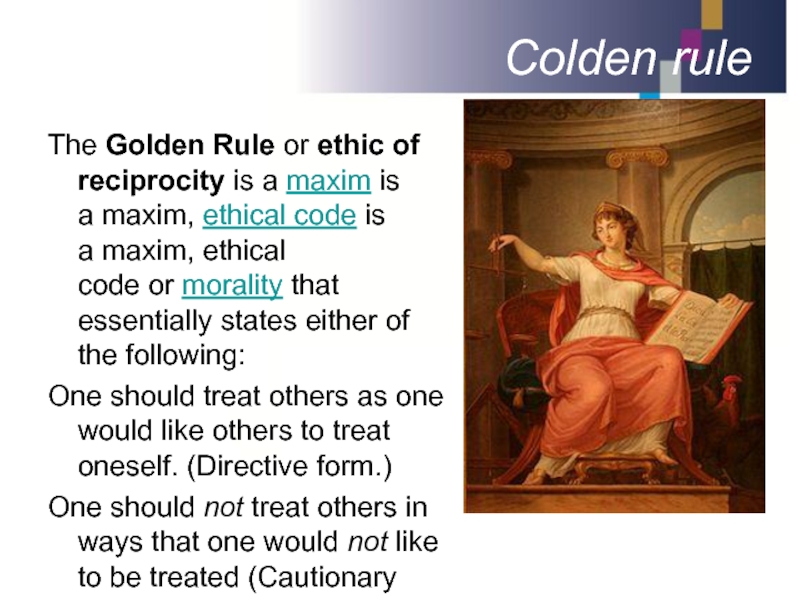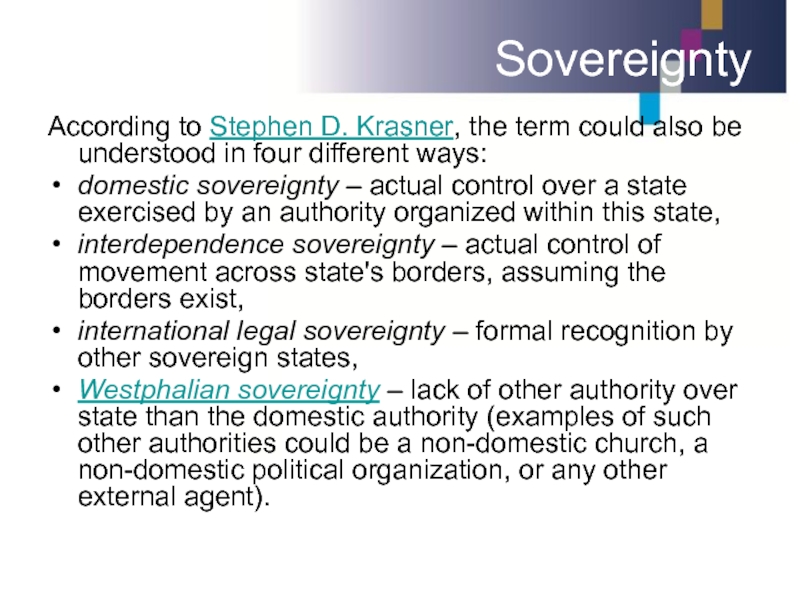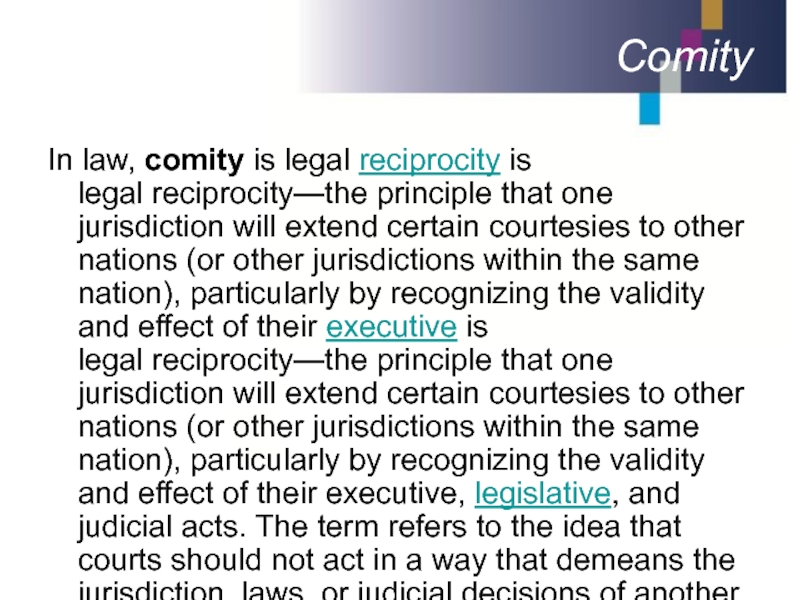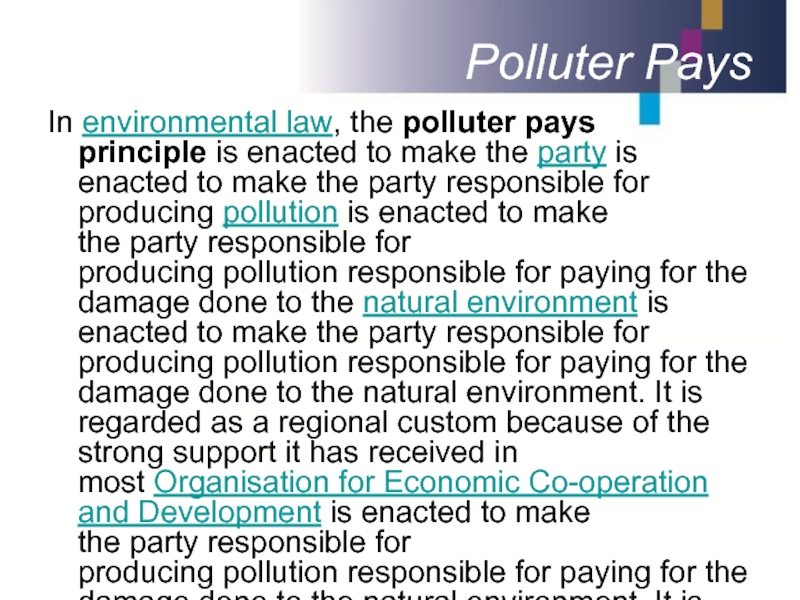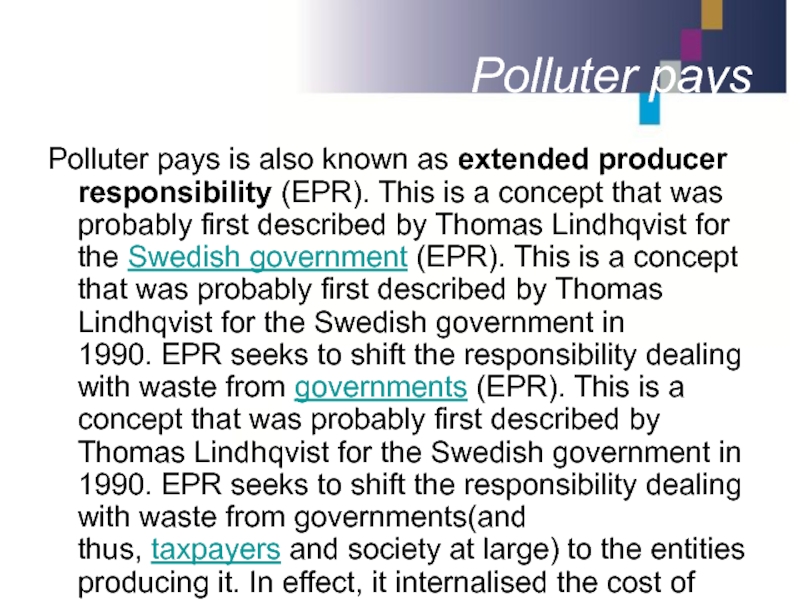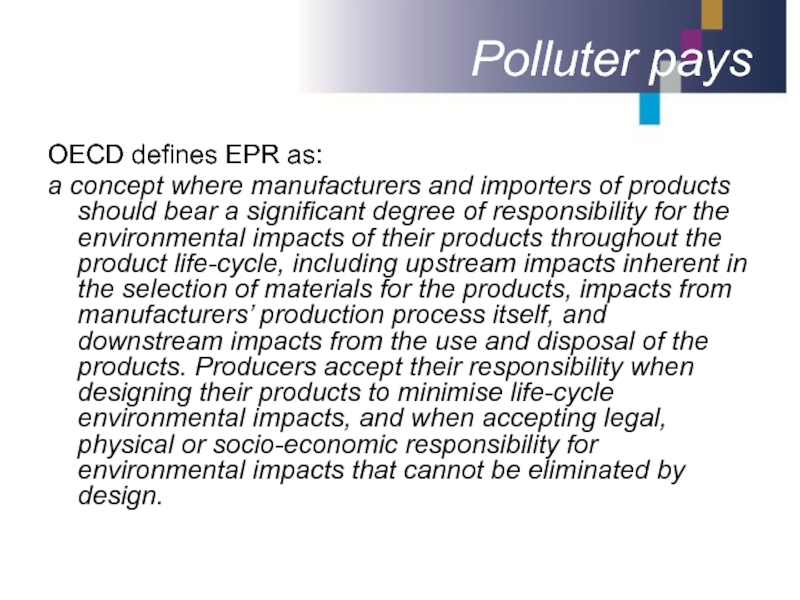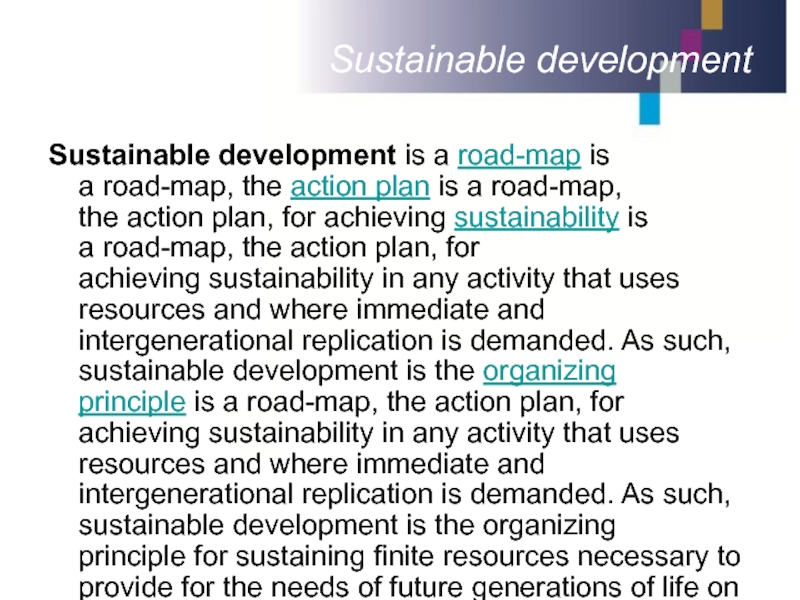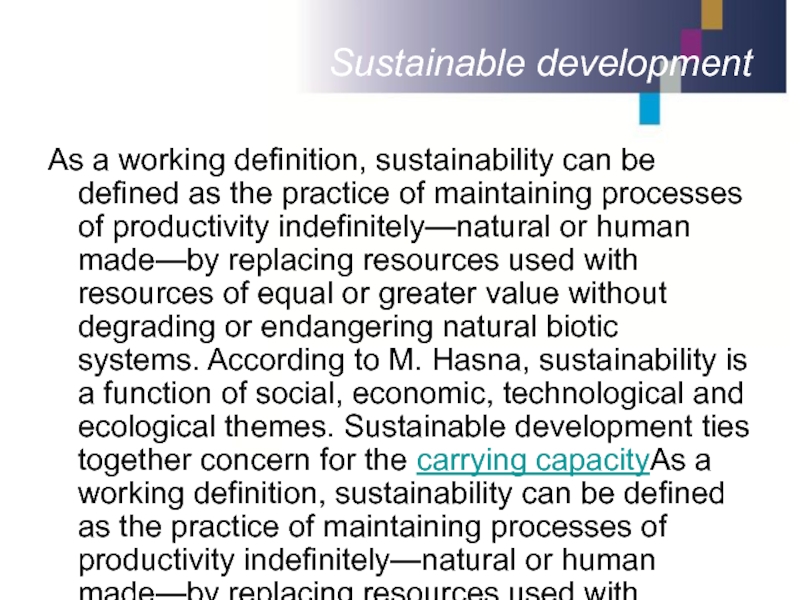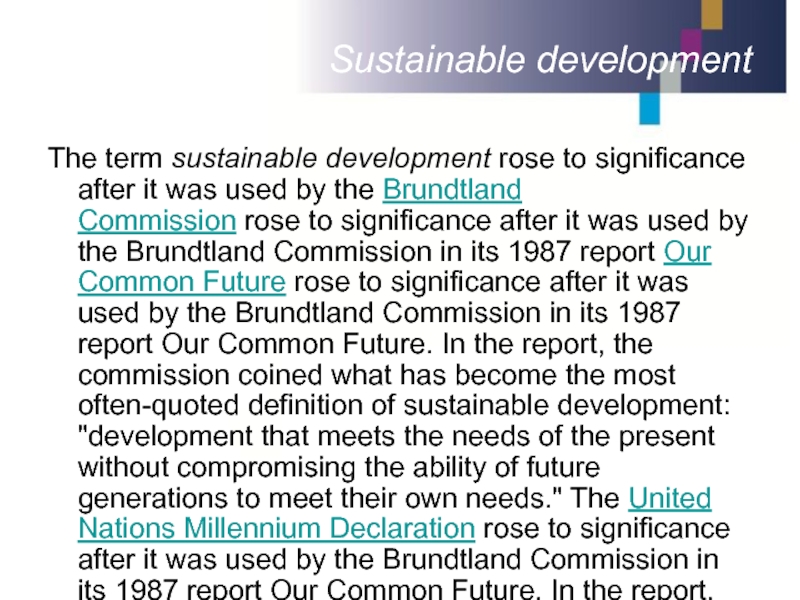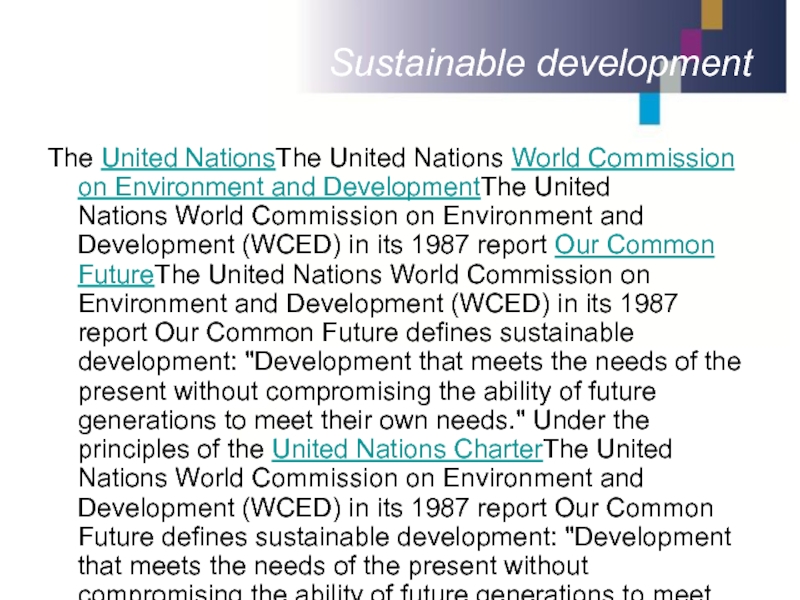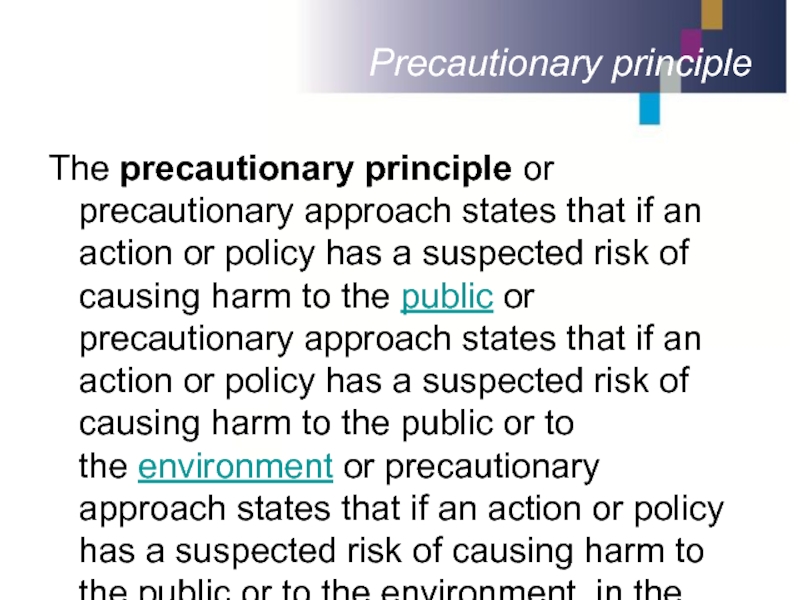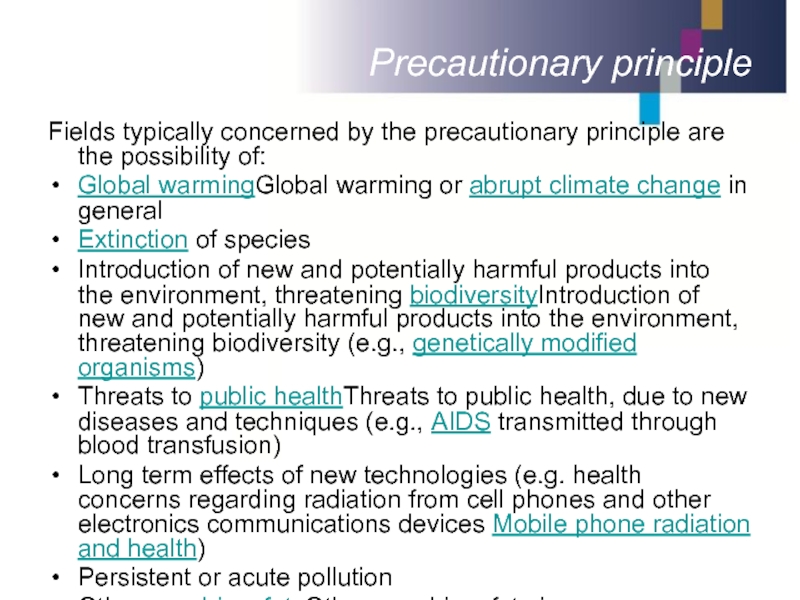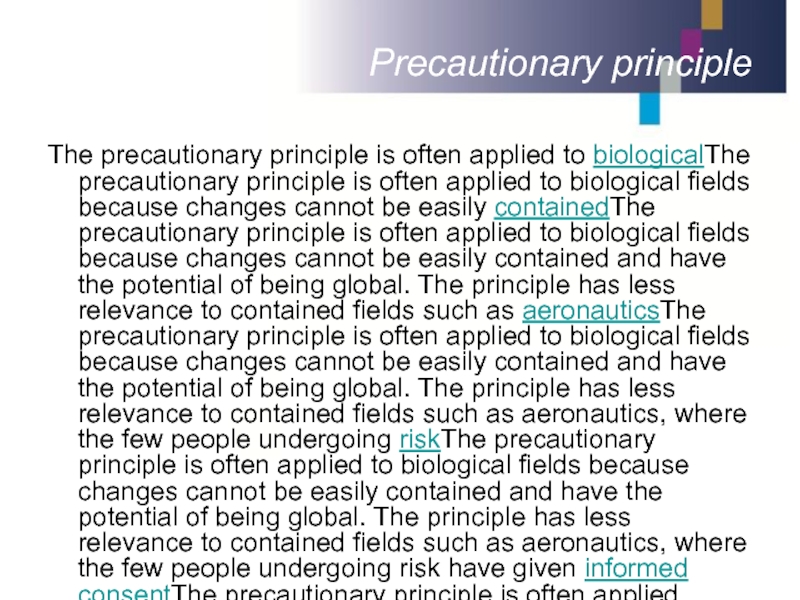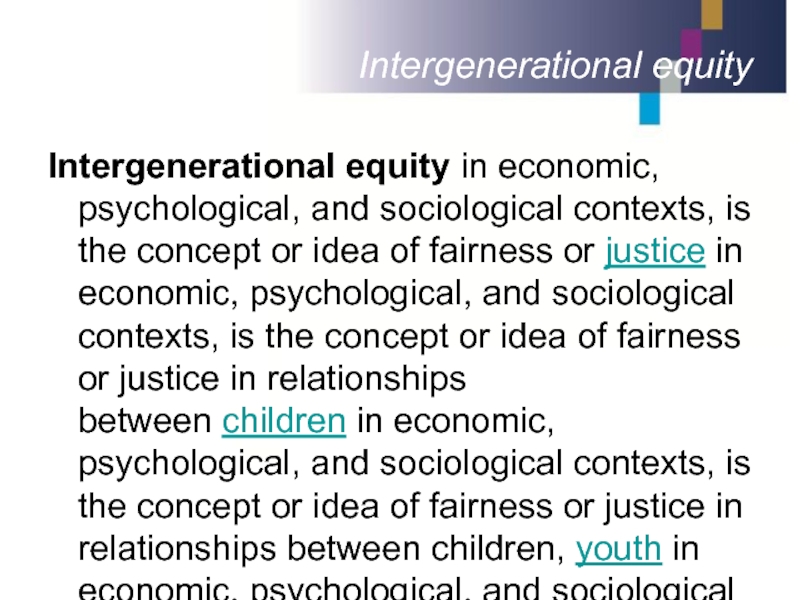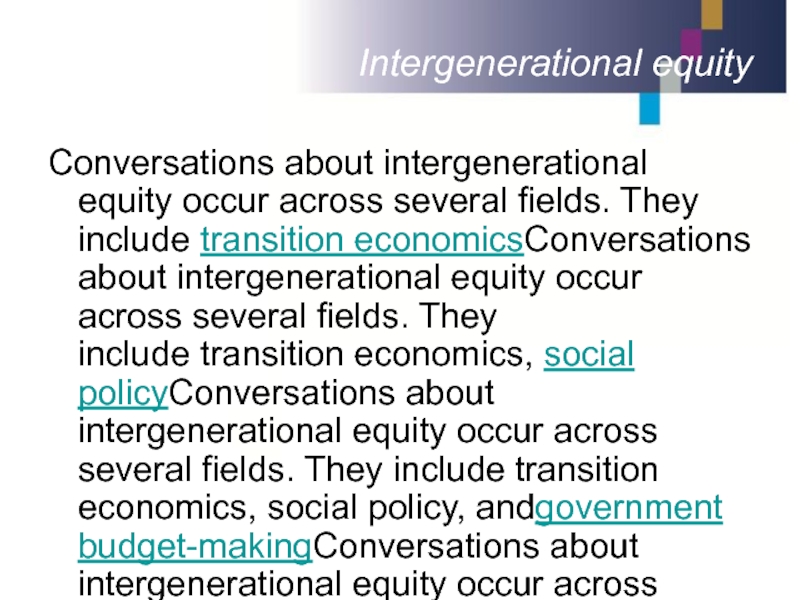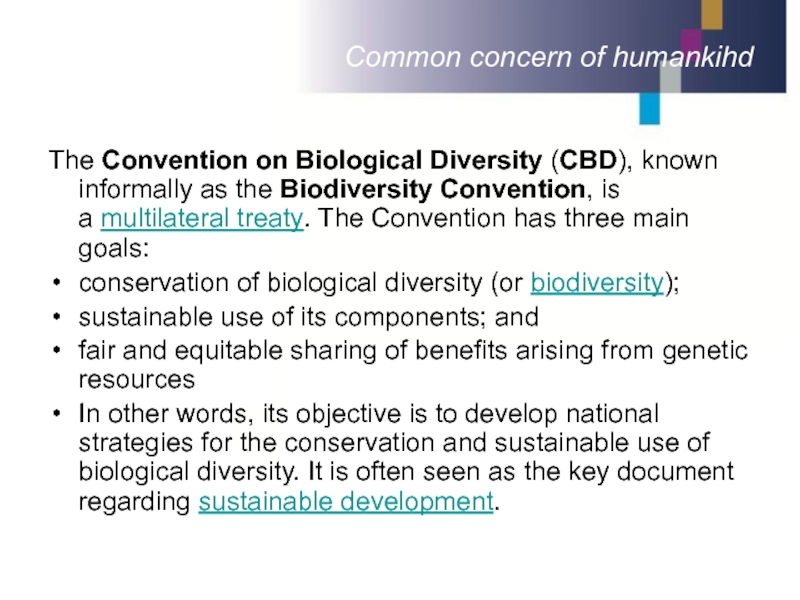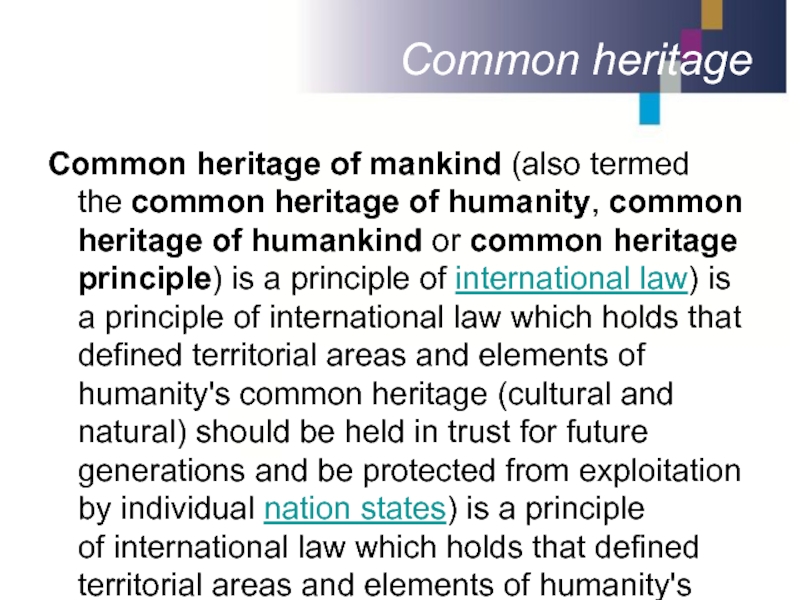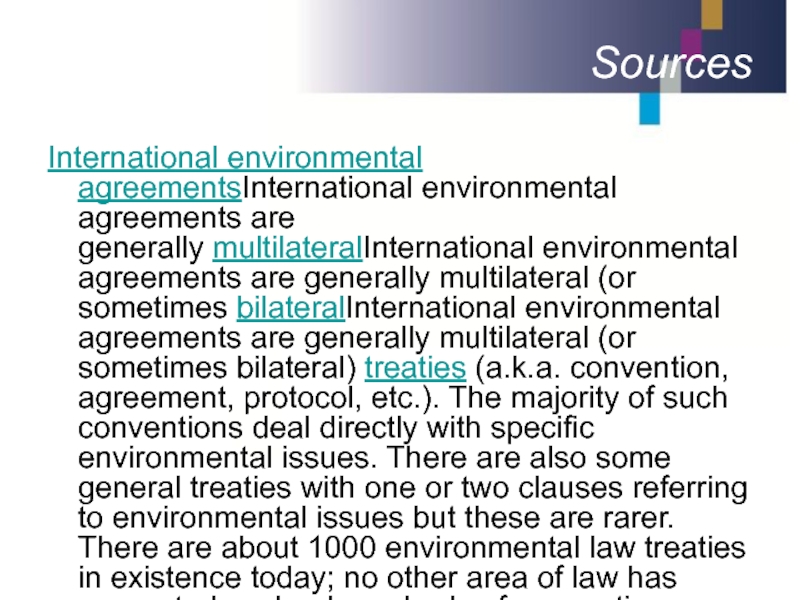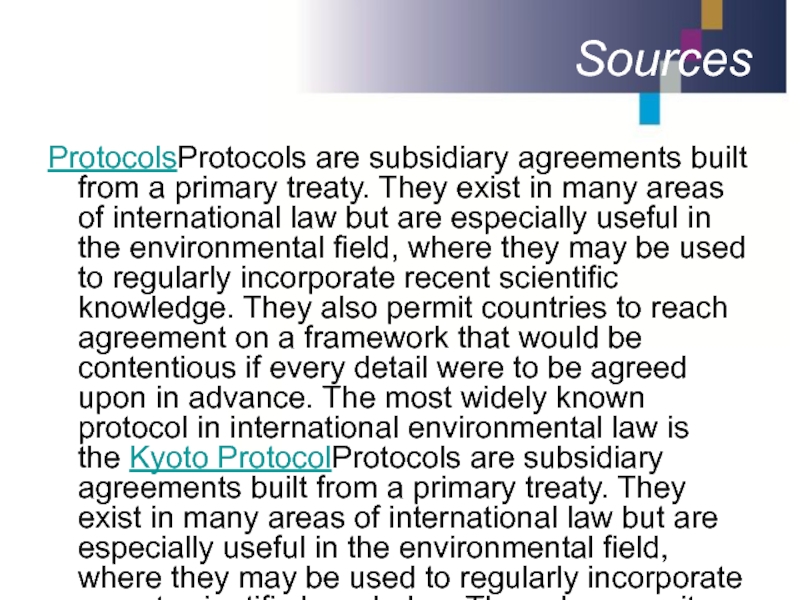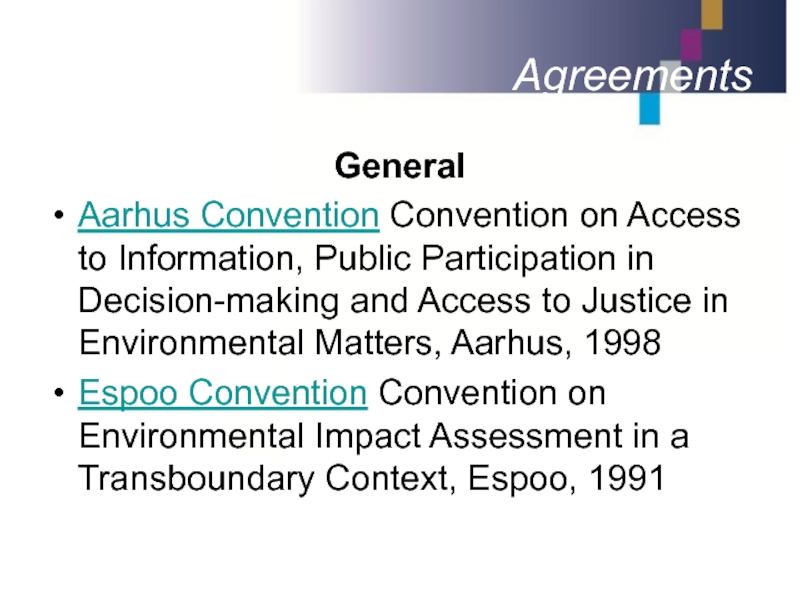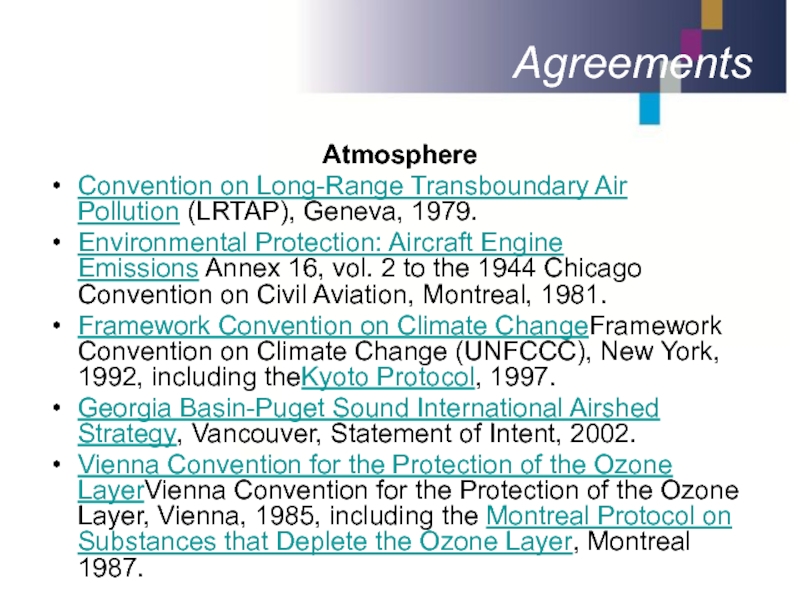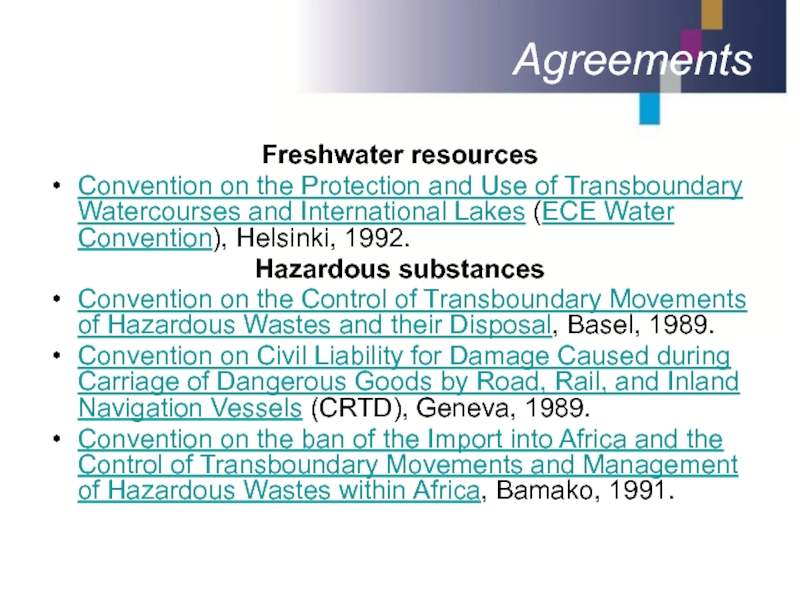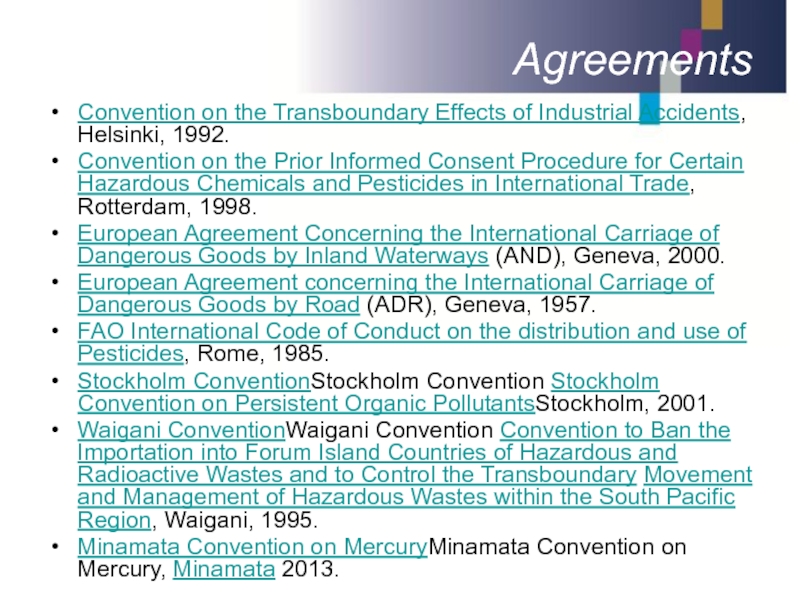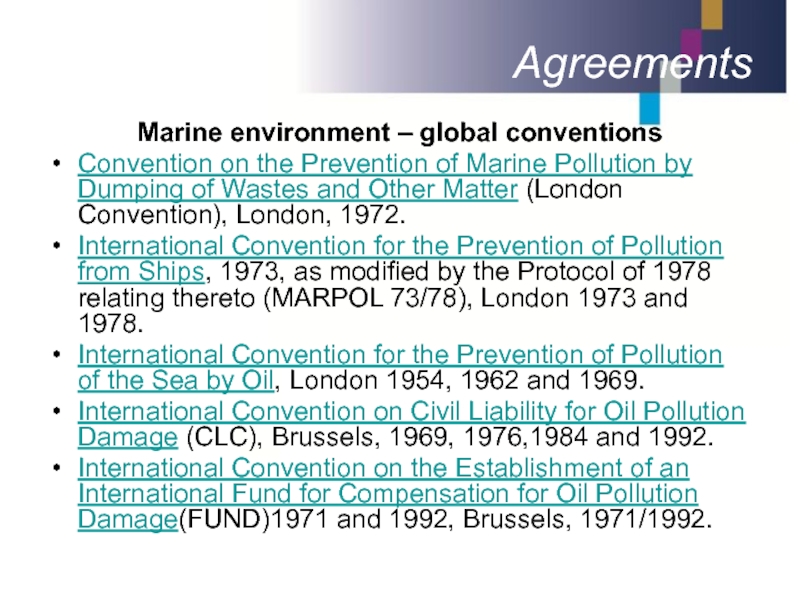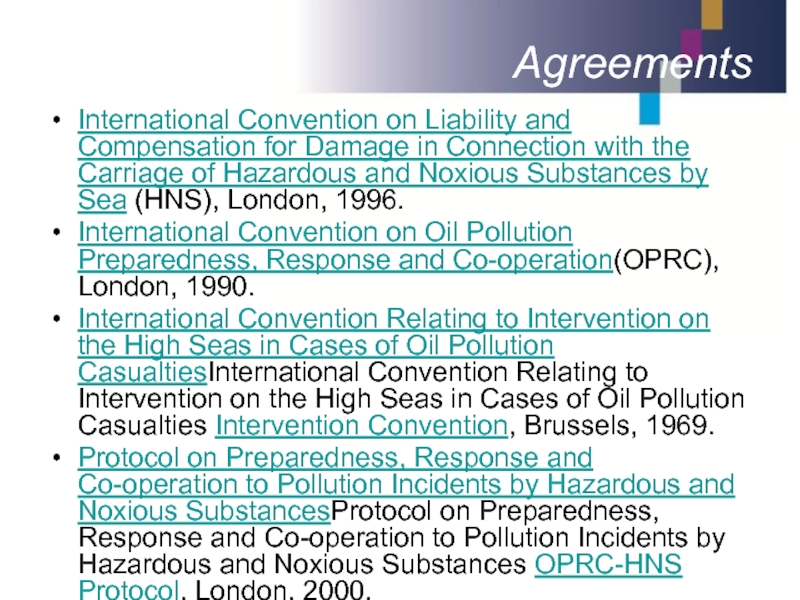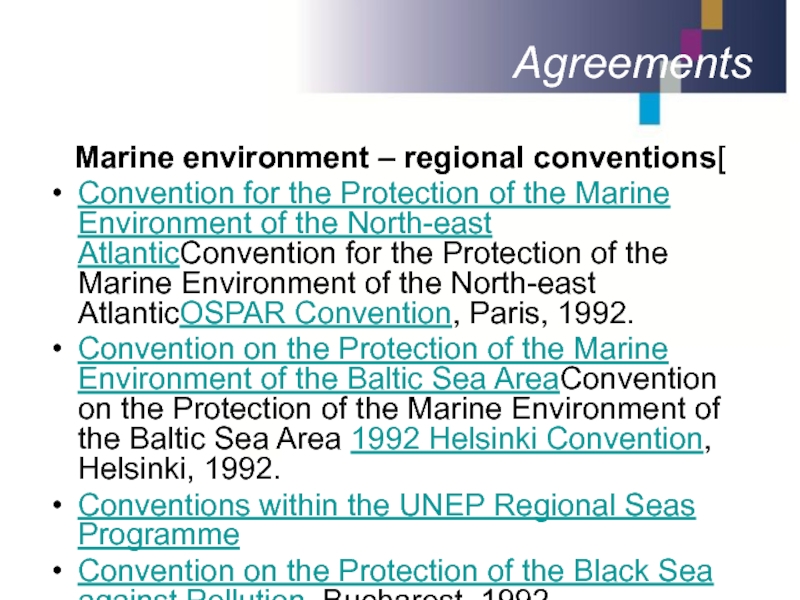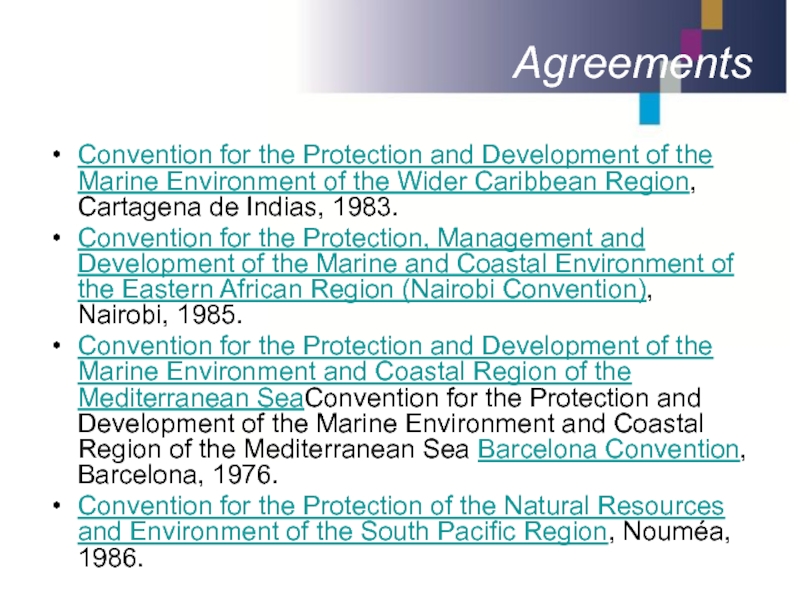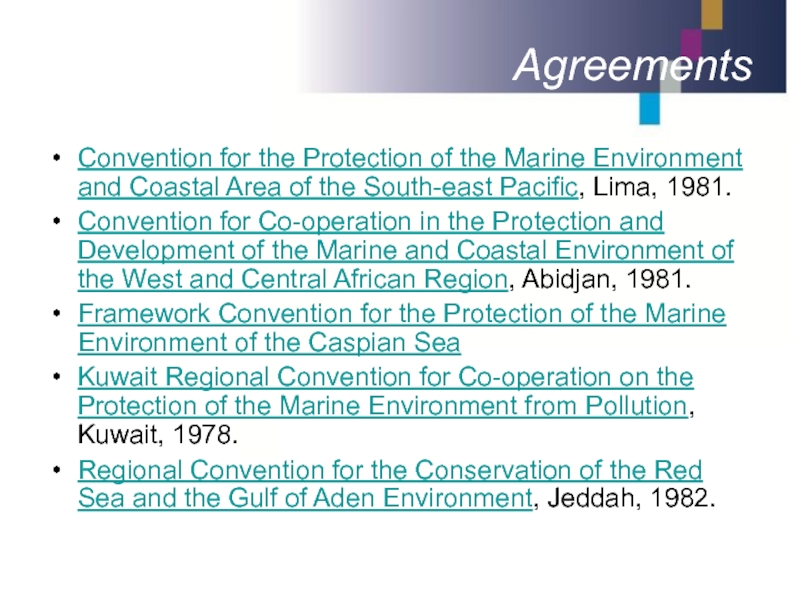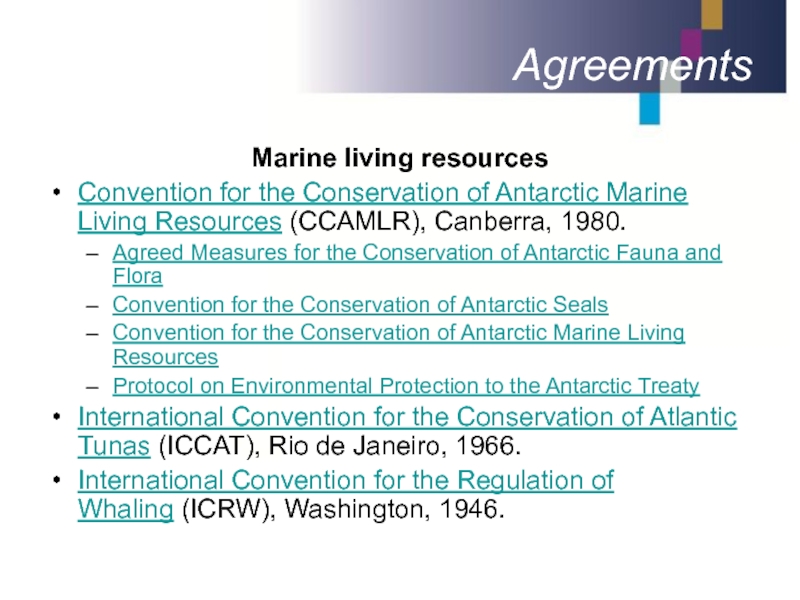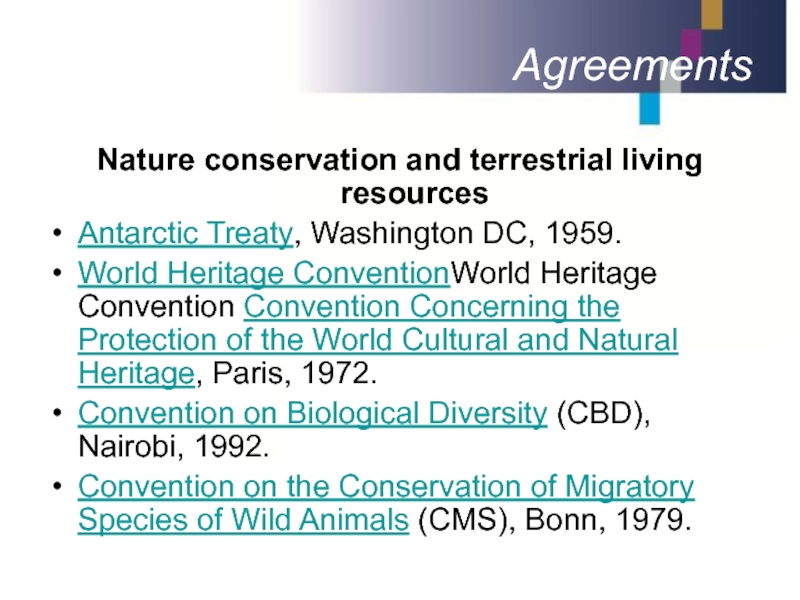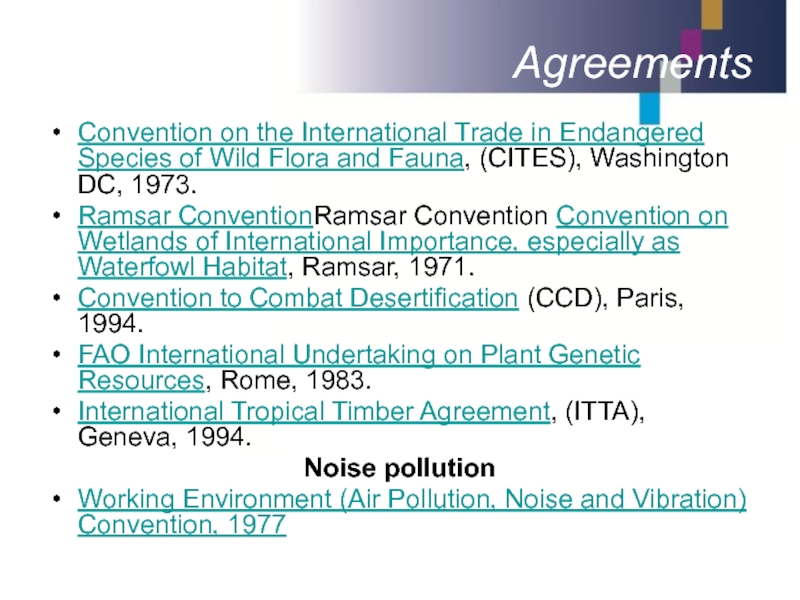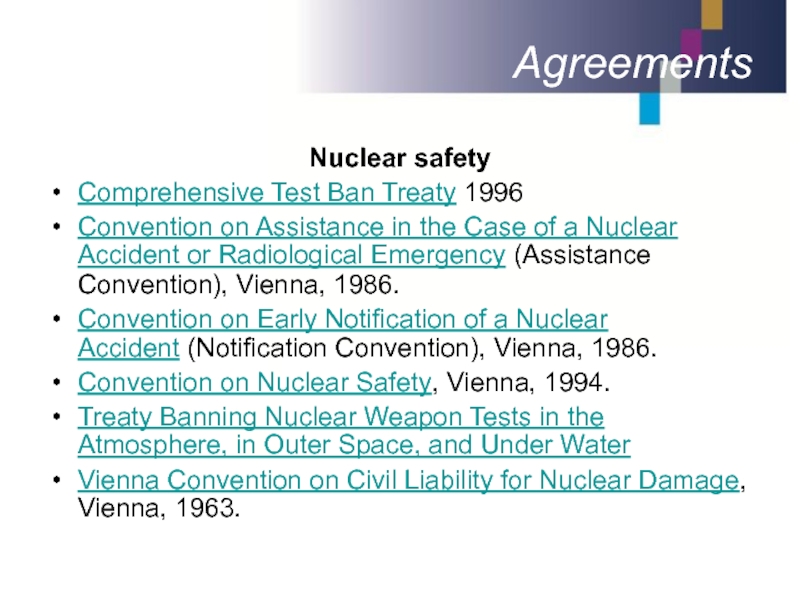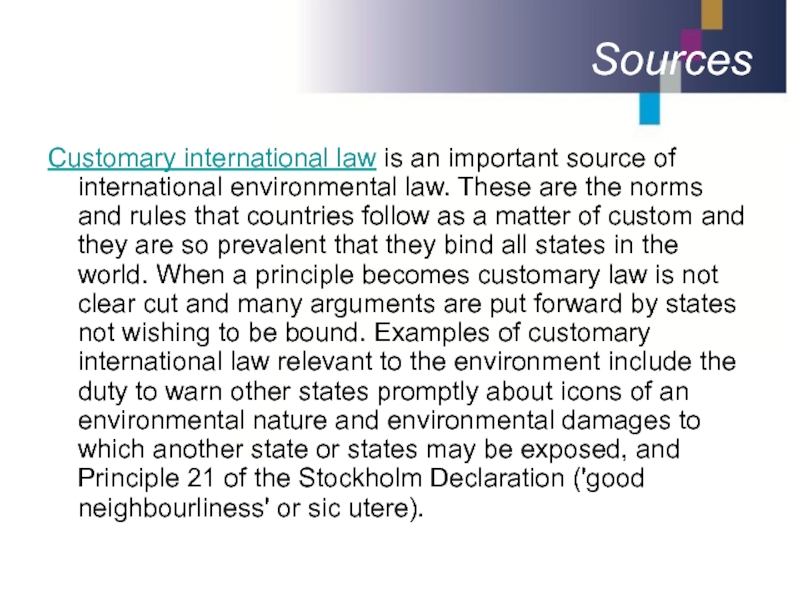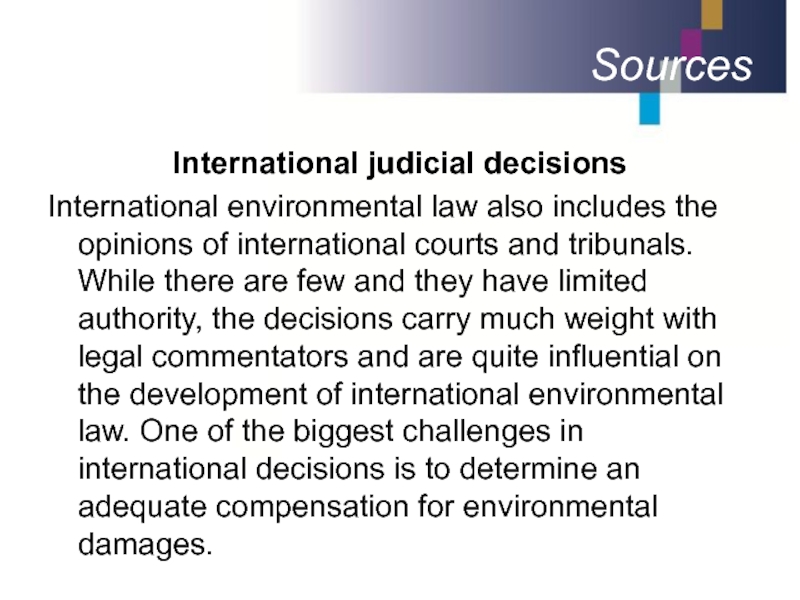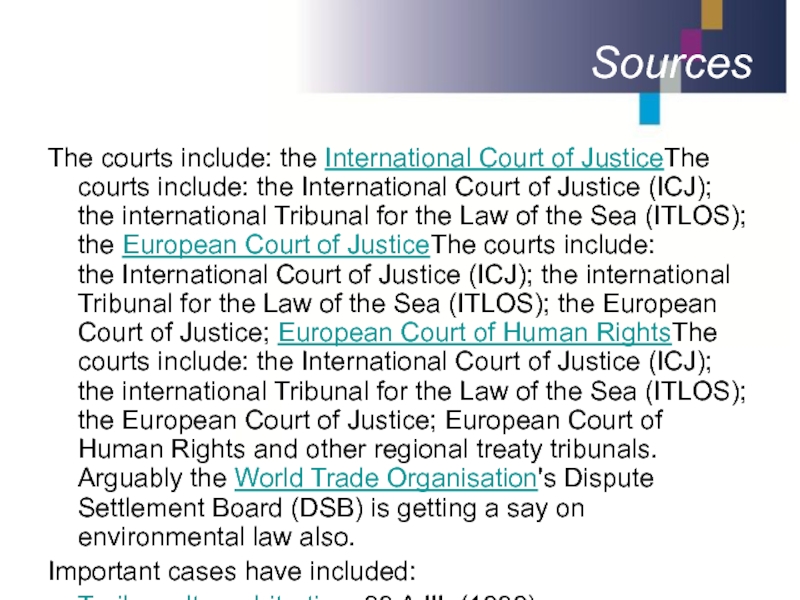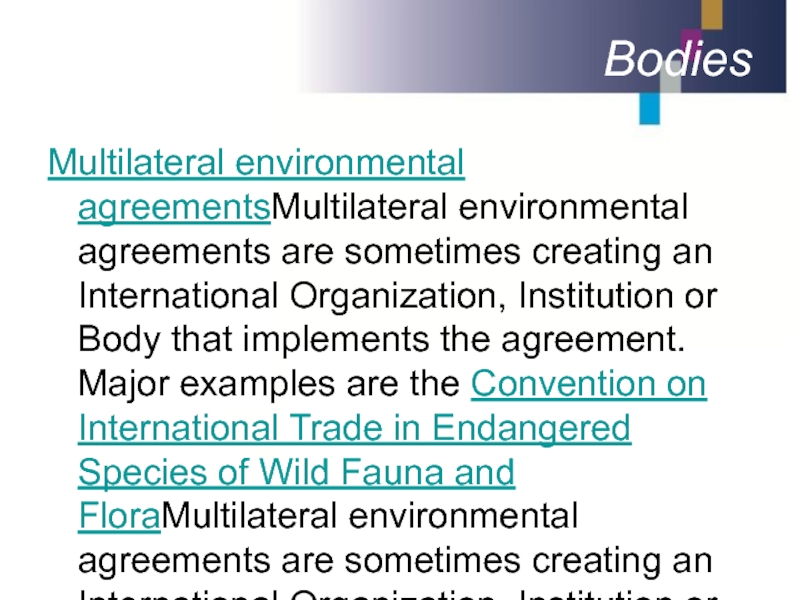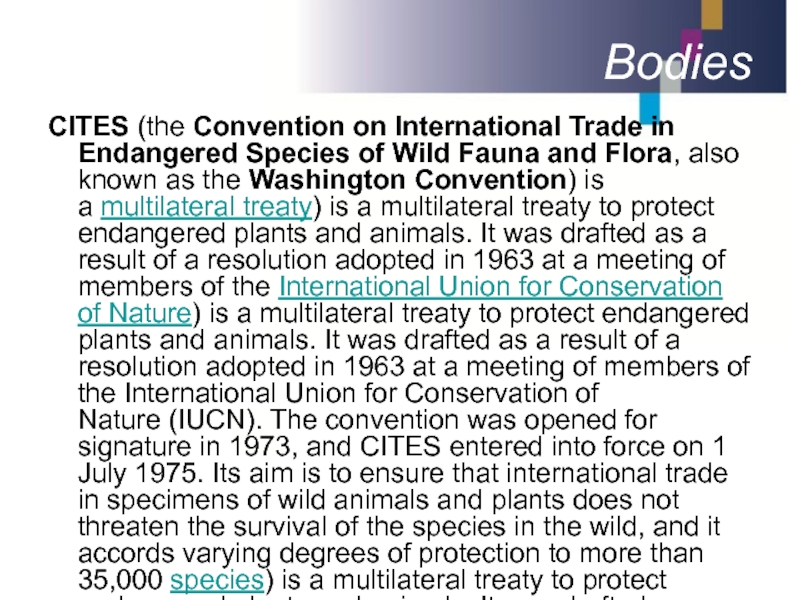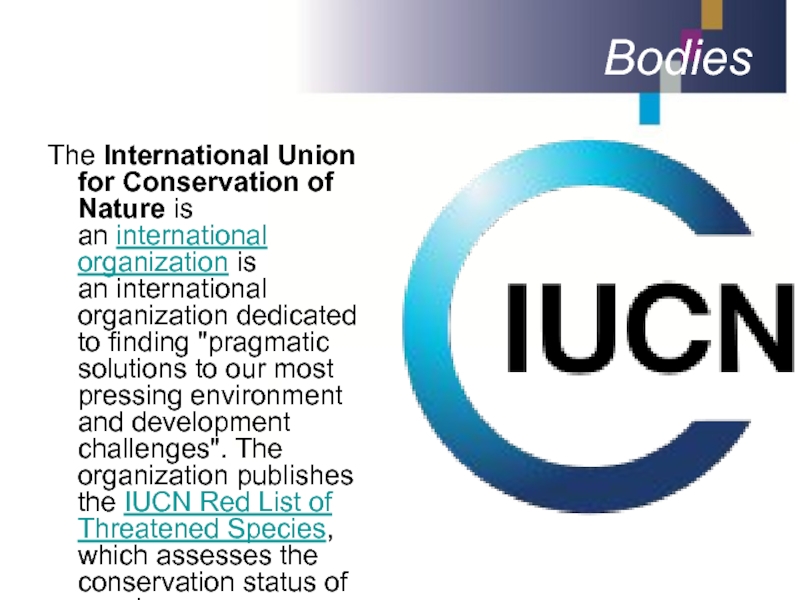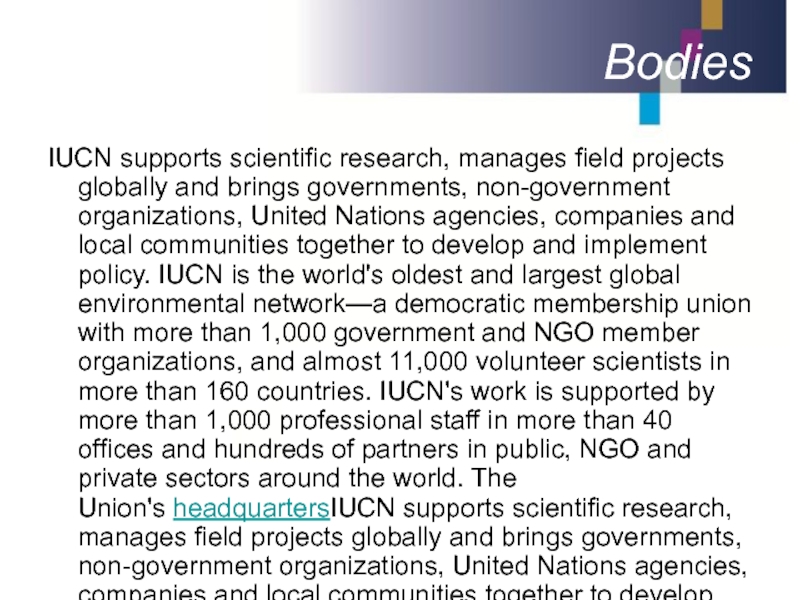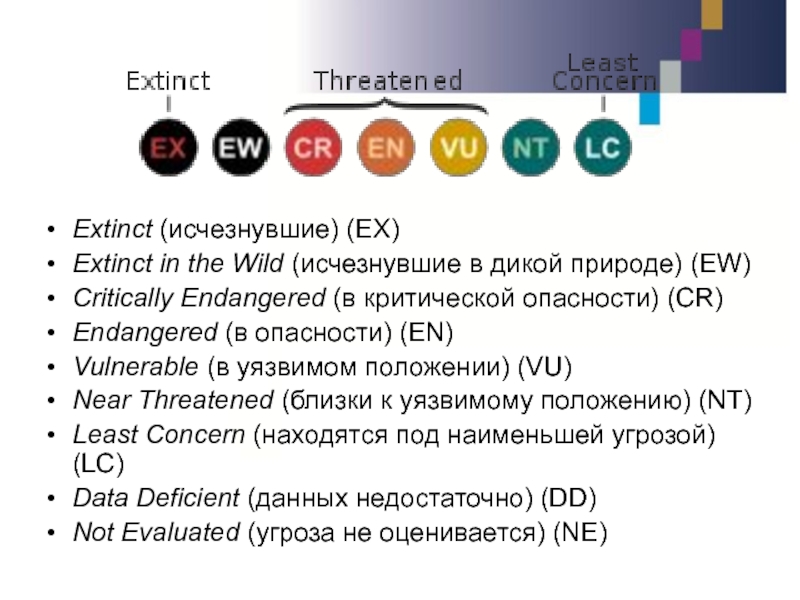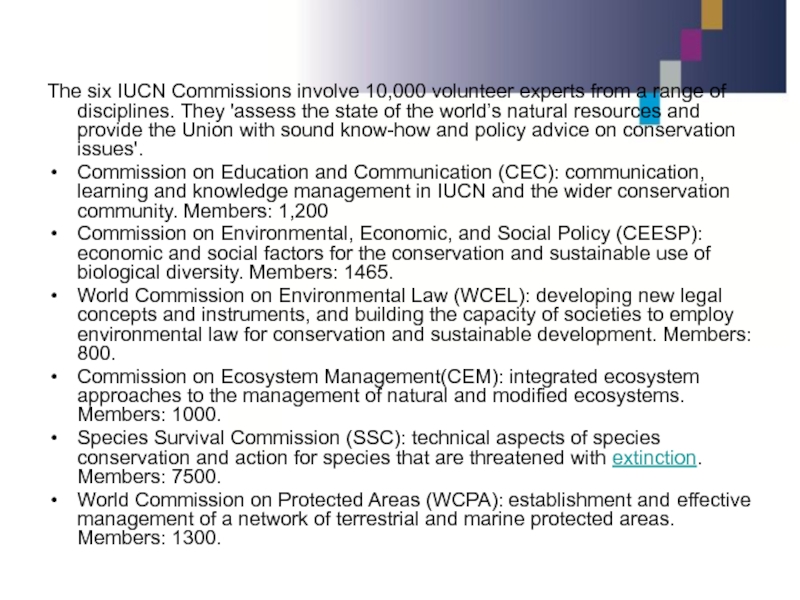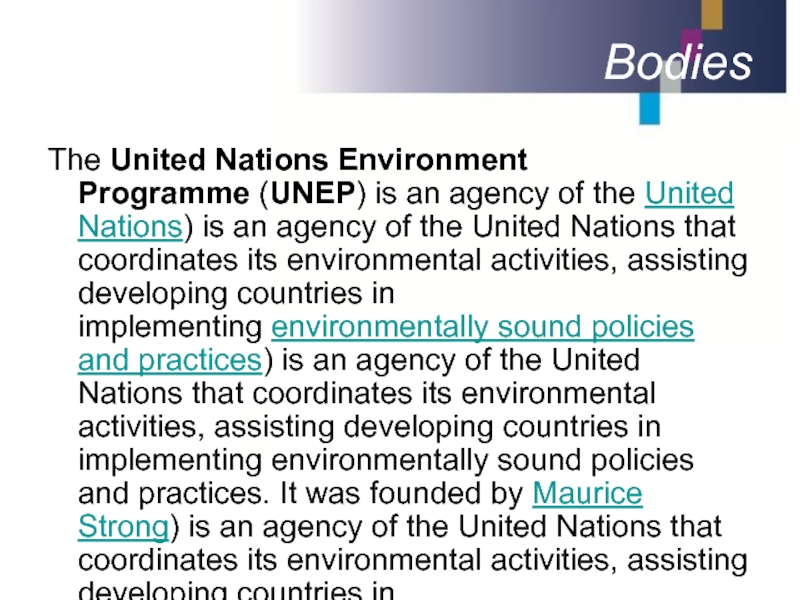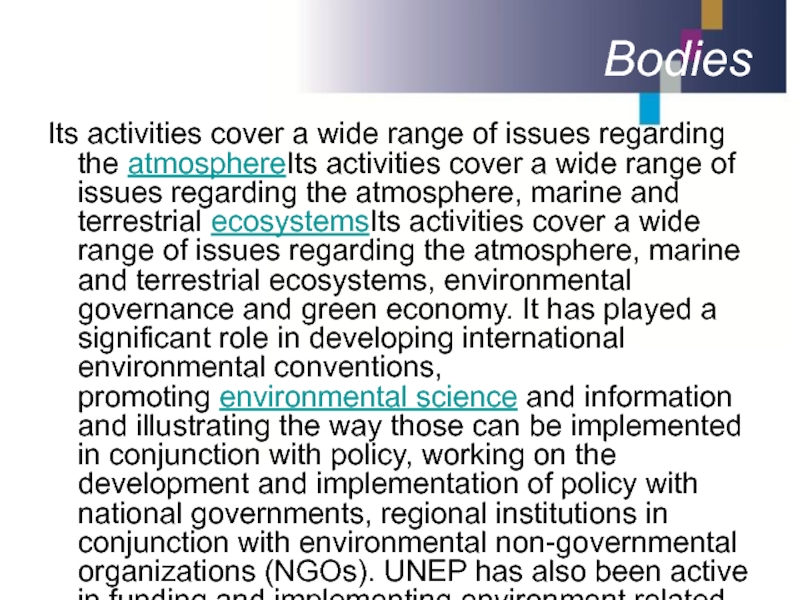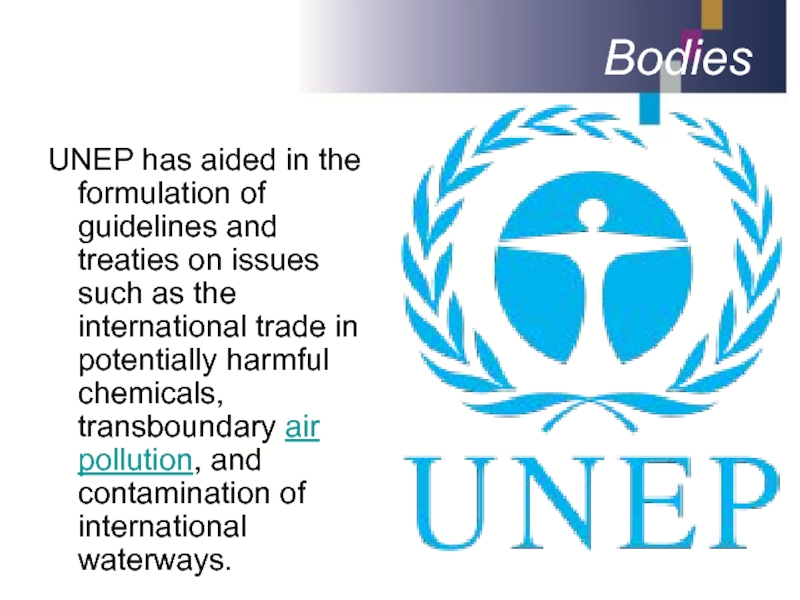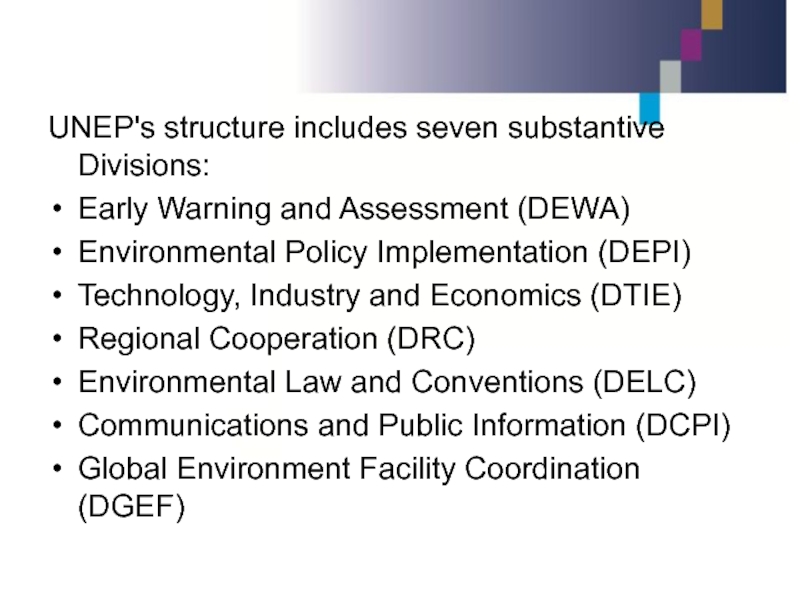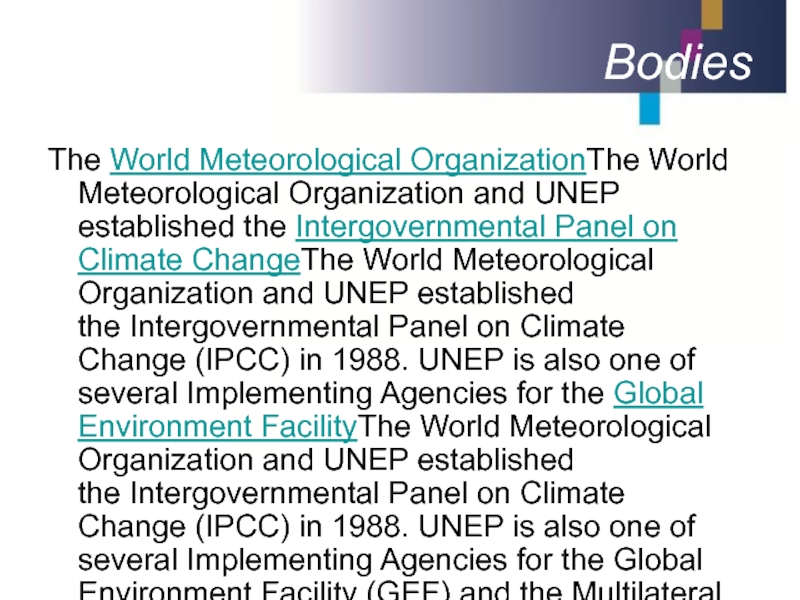- Главная
- Разное
- Дизайн
- Бизнес и предпринимательство
- Аналитика
- Образование
- Развлечения
- Красота и здоровье
- Финансы
- Государство
- Путешествия
- Спорт
- Недвижимость
- Армия
- Графика
- Культурология
- Еда и кулинария
- Лингвистика
- Английский язык
- Астрономия
- Алгебра
- Биология
- География
- Детские презентации
- Информатика
- История
- Литература
- Маркетинг
- Математика
- Медицина
- Менеджмент
- Музыка
- МХК
- Немецкий язык
- ОБЖ
- Обществознание
- Окружающий мир
- Педагогика
- Русский язык
- Технология
- Физика
- Философия
- Химия
- Шаблоны, картинки для презентаций
- Экология
- Экономика
- Юриспруденция
International Environmental Law: subject, sources презентация
Содержание
- 1. International Environmental Law: subject, sources
- 2. International law is the set of rules generally
- 3. The term "international law" can refer to
- 4. The two traditional branches of the field
- 5. Public international law concerns the structure and conduct
- 6. Under article 38 of the Statute of the
- 7. System of international law General part Special
- 8. Pollution, scarce resources, wild animals and plants
- 9. International environmental law's development has included the
- 10. The Golden Rule or ethic of reciprocity is a maxim is a maxim, ethical code is
- 11. Sovereignty According to Stephen D. Krasner, the term
- 12. Comity In law, comity is legal reciprocity is legal reciprocity—the principle that
- 13. Polluter Pays In environmental law, the polluter pays principle is
- 14. Polluter pays Polluter pays is also known
- 15. Polluter pays OECD defines EPR as: a
- 16. Sustainable development Sustainable development is a road-map is a road-map, the action
- 17. Sustainable development As a working definition, sustainability
- 18. Sustainable development The term sustainable development rose to significance
- 19. Sustainable development The United NationsThe United Nations World Commission on
- 20. Precautionary principle The precautionary principle or precautionary approach states
- 21. Precautionary principle Fields typically concerned by the
- 22. Precautionary principle The precautionary principle is often
- 23. Intergenerational equity Intergenerational equity in economic, psychological, and
- 24. Intergenerational equity Conversations about intergenerational equity occur
- 25. Common concern of humankihd The Convention on Biological
- 26. Common heritage Common heritage of mankind (also termed
- 27. Sources International environmental agreementsInternational environmental agreements are generally multilateralInternational
- 28. Sources ProtocolsProtocols are subsidiary agreements built from a
- 29. Agreements General Aarhus Convention Convention on Access to
- 30. Agreements Atmosphere Convention on Long-Range Transboundary Air
- 31. Agreements Freshwater resources Convention on the Protection
- 32. Agreements Convention on the Transboundary Effects of
- 33. Agreements Marine environment – global conventions Convention
- 34. Agreements International Convention on Liability and Compensation
- 35. Agreements Marine environment – regional conventions[ Convention
- 36. Agreements Convention for the Protection and Development
- 37. Agreements Convention for the Protection of the
- 38. Agreements Marine living resources Convention for the
- 39. Agreements Nature conservation and terrestrial living resources
- 40. Agreements Convention on the International Trade in
- 41. Agreements Nuclear safety Comprehensive Test Ban Treaty 1996
- 42. Sources Customary international law is an important source
- 43. Sources International judicial decisions International environmental law
- 44. Sources The courts include: the International Court of
- 45. Bodies Multilateral environmental agreementsMultilateral environmental agreements are sometimes
- 46. Bodies CITES (the Convention on International Trade in Endangered
- 47. Bodies The International Union for Conservation of Nature
- 48. Bodies IUCN supports scientific research, manages field
- 49. Extinct (исчезнувшие) (EX) Extinct in the Wild (исчезнувшие в
- 50. The six IUCN Commissions involve 10,000 volunteer
- 51. Bodies The United Nations Environment Programme (UNEP) is an
- 52. Bodies Its activities cover a wide range
- 53. Bodies UNEP has aided in the formulation
- 54. UNEP's structure includes seven substantive Divisions: Early
- 55. Bodies The World Meteorological OrganizationThe World Meteorological Organization and UNEP
- 56. Thank you!
Слайд 2International law is the set of rules generally regarded and accepted as
binding in relations between states and between nations. It serves as a framework for the practice of stable and organized international relations. International law differs from state-based legal systems in that it is primarily applicable to countries rather than to private citizens.
Слайд 3The term "international law" can refer to three distinct legal disciplines:
-
Public international law- Public international law, which governs the relationship between states and international entities. It includes these legal fields: treaty law- Public international law, which governs the relationship between states and international entities. It includes these legal fields: treaty law, law of sea- Public international law, which governs the relationship between states and international entities. It includes these legal fields: treaty law, law of sea, international criminal law- Public international law, which governs the relationship between states and international entities. It includes these legal fields: treaty law, law of sea, international criminal law, the laws of war- Public international law, which governs the relationship between states and international entities. It includes these legal fields: treaty law, law of sea, international criminal law, the laws of war or international humanitarian law- Public international law, which governs the relationship between states and international entities. It includes these legal fields: treaty law, law of sea, international criminal law, the laws of war or international humanitarian law and international human rights law.
- Private international law, or conflict of laws, which addresses the questions of (1) which jurisdiction may hear a case, and (2) the law concerning which jurisdiction applies to the issues in the case.
- Supranational law- Supranational law or the law of supranational- Supranational law or the law of supranational organizations, which concerns regional agreements where the laws of nation states may be held inapplicable when conflicting with a supranational legal system when that nation has a treaty obligation to a supranational collective.
- Private international law, or conflict of laws, which addresses the questions of (1) which jurisdiction may hear a case, and (2) the law concerning which jurisdiction applies to the issues in the case.
- Supranational law- Supranational law or the law of supranational- Supranational law or the law of supranational organizations, which concerns regional agreements where the laws of nation states may be held inapplicable when conflicting with a supranational legal system when that nation has a treaty obligation to a supranational collective.
Слайд 4The two traditional branches of the field are:
jus gentium – law of
nations
jus inter gentes – agreements between nations
jus inter gentes – agreements between nations
Слайд 5Public international law concerns the structure and conduct of sovereign states concerns the structure
and conduct of sovereign states; analogous entities, such as the Holy See concerns the structure and conduct of sovereign states; analogous entities, such as the Holy See; and intergovernmental organizations concerns the structure and conduct of sovereign states; analogous entities, such as the Holy See; and intergovernmental organizations. To a lesser degree, international law also may affect multinational corporations concerns the structure and conduct of sovereign states; analogous entities, such as the Holy See; and intergovernmental organizations. To a lesser degree, international law also may affect multinational corporations and individuals concerns the structure and conduct of sovereign states; analogous entities, such as the Holy See; and intergovernmental organizations. To a lesser degree, international law also may affect multinational corporations and individuals, an impact increasingly evolving beyond domestic legal interpretation and enforcement. Public international law has increased in use and importance vastly over the twentieth century, due to the increase in global trade concerns the structure and conduct of sovereign states; analogous entities, such as the Holy See; and intergovernmental organizations. To a lesser degree, international law also may affect multinational corporations and individuals, an impact increasingly evolving beyond domestic legal interpretation and enforcement. Public international law has increased in use and importance vastly over the twentieth century, due to the increase in global trade, environmental deterioration on a worldwide scale, awareness of human rights violations, rapid and vast increases in international transportation and a boom in global communications.
Слайд 6Under article 38 of the Statute of the International Court of Justice,
public international law has three principal sources: international treaties, custom, and general principles of law. In addition, judicial decisions and teachings may be applied as "subsidiary means for the determination of rules of law".
Слайд 7System of international law
General part
Special part
International law of human rights
International sea
law
International space law
International security law
International environmental law etc.
International space law
International security law
International environmental law etc.
Слайд 8Pollution, scarce resources, wild animals and plants do not respect political
boundaries, making treatiesPollution, scarce resources, wild animals and plants do not respect political boundaries, making treaties an important aspect of environmental law. Numerous legally binding international agreements now encompass a wide variety of issue-areas, from terrestrial, marine and atmospheric pollution through to wildlife and biodiversity protection.
While the bodies that proposed, argued, agreed upon and ultimately adopted existing international agreements vary according to each agreement, certain conferences, including 1972's United Nations Conference on the Human EnvironmentWhile the bodies that proposed, argued, agreed upon and ultimately adopted existing international agreements vary according to each agreement, certain conferences, including 1972's United Nations Conference on the Human Environment, 1983's World Commission on Environment and DevelopmentWhile the bodies that proposed, argued, agreed upon and ultimately adopted existing international agreements vary according to each agreement, certain conferences, including 1972's United Nations Conference on the Human Environment, 1983's World Commission on Environment and Development, 1992's United Nations Conference on Environment and DevelopmentWhile the bodies that proposed, argued, agreed upon and ultimately adopted existing international agreements vary according to each agreement, certain conferences, including 1972's United Nations Conference on the Human Environment, 1983's World Commission on Environment and Development, 1992's United Nations Conference on Environment and Development and 2002's World Summit on Sustainable Development have been particularly important.
While the bodies that proposed, argued, agreed upon and ultimately adopted existing international agreements vary according to each agreement, certain conferences, including 1972's United Nations Conference on the Human EnvironmentWhile the bodies that proposed, argued, agreed upon and ultimately adopted existing international agreements vary according to each agreement, certain conferences, including 1972's United Nations Conference on the Human Environment, 1983's World Commission on Environment and DevelopmentWhile the bodies that proposed, argued, agreed upon and ultimately adopted existing international agreements vary according to each agreement, certain conferences, including 1972's United Nations Conference on the Human Environment, 1983's World Commission on Environment and Development, 1992's United Nations Conference on Environment and DevelopmentWhile the bodies that proposed, argued, agreed upon and ultimately adopted existing international agreements vary according to each agreement, certain conferences, including 1972's United Nations Conference on the Human Environment, 1983's World Commission on Environment and Development, 1992's United Nations Conference on Environment and Development and 2002's World Summit on Sustainable Development have been particularly important.
Слайд 9International environmental law's development has included the statement and adoption of
a number of important guiding principles. As with all international law, international environmental law brings up questions of sovereigntyInternational environmental law's development has included the statement and adoption of a number of important guiding principles. As with all international law, international environmental law brings up questions of sovereignty, legal reciprocity ("comityInternational environmental law's development has included the statement and adoption of a number of important guiding principles. As with all international law, international environmental law brings up questions of sovereignty, legal reciprocity ("comity") and even perhaps the Golden RuleInternational environmental law's development has included the statement and adoption of a number of important guiding principles. As with all international law, international environmental law brings up questions of sovereignty, legal reciprocity ("comity") and even perhaps the Golden Rule. Other guiding principles include the polluter pays principleInternational environmental law's development has included the statement and adoption of a number of important guiding principles. As with all international law, international environmental law brings up questions of sovereignty, legal reciprocity ("comity") and even perhaps the Golden Rule. Other guiding principles include the polluter pays principle, the precautionary principleInternational environmental law's development has included the statement and adoption of a number of important guiding principles. As with all international law, international environmental law brings up questions of sovereignty, legal reciprocity ("comity") and even perhaps the Golden Rule. Other guiding principles include the polluter pays principle, the precautionary principle, the principle of sustainable developmentInternational environmental law's development has included the statement and adoption of a number of important guiding principles. As with all international law, international environmental law brings up questions of sovereignty, legal reciprocity ("comity") and even perhaps the Golden Rule. Other guiding principles include the polluter pays principle, the precautionary principle, the principle of sustainable development, environmental procedural rightsInternational environmental law's development has included the statement and adoption of a number of important guiding principles. As with all international law, international environmental law brings up questions of sovereignty, legal reciprocity ("comity") and even perhaps the Golden Rule. Other guiding principles include the polluter pays principle, the precautionary principle, the principle of sustainable development, environmental procedural rights, common but differentiated responsibilities, intragenerational and intergenerational equityInternational environmental law's development has included the statement and adoption of a number of important guiding principles. As with all international law, international environmental law brings up questions of sovereignty, legal reciprocity ("comity") and even perhaps the Golden Rule. Other guiding principles include the polluter pays principle, the precautionary principle, the principle of sustainable development, environmental procedural rights, common but differentiated responsibilities, intragenerational and intergenerational equity, "common concern of humankindInternational environmental law's development has included the statement and adoption of a number of important guiding principles. As with all international law, international environmental law brings up questions of sovereignty, legal reciprocity ("comity") and even perhaps the Golden Rule. Other guiding principles include the polluter pays principle, the precautionary principle, the principle of sustainable development, environmental procedural rights, common but differentiated responsibilities, intragenerational and intergenerational equity, "common concern of humankind", and common heritage.
Слайд 10The Golden Rule or ethic of reciprocity is a maxim is a maxim, ethical code is a maxim, ethical code or morality that essentially states
either of the following:
One should treat others as one would like others to treat oneself. (Directive form.)
One should not treat others in ways that one would not like to be treated (Cautionary form, also known as the Silver Rule).
One should treat others as one would like others to treat oneself. (Directive form.)
One should not treat others in ways that one would not like to be treated (Cautionary form, also known as the Silver Rule).
Colden rule
Слайд 11Sovereignty
According to Stephen D. Krasner, the term could also be understood in
four different ways:
domestic sovereignty – actual control over a state exercised by an authority organized within this state,
interdependence sovereignty – actual control of movement across state's borders, assuming the borders exist,
international legal sovereignty – formal recognition by other sovereign states,
Westphalian sovereignty – lack of other authority over state than the domestic authority (examples of such other authorities could be a non-domestic church, a non-domestic political organization, or any other external agent).
domestic sovereignty – actual control over a state exercised by an authority organized within this state,
interdependence sovereignty – actual control of movement across state's borders, assuming the borders exist,
international legal sovereignty – formal recognition by other sovereign states,
Westphalian sovereignty – lack of other authority over state than the domestic authority (examples of such other authorities could be a non-domestic church, a non-domestic political organization, or any other external agent).
Слайд 12Comity
In law, comity is legal reciprocity is legal reciprocity—the principle that one jurisdiction will extend certain
courtesies to other nations (or other jurisdictions within the same nation), particularly by recognizing the validity and effect of their executive is legal reciprocity—the principle that one jurisdiction will extend certain courtesies to other nations (or other jurisdictions within the same nation), particularly by recognizing the validity and effect of their executive, legislative, and judicial acts. The term refers to the idea that courts should not act in a way that demeans the jurisdiction, laws, or judicial decisions of another jurisdiction. Part of the presumption of comity is that other jurisdictions will reciprocate the courtesy shown to them.
Слайд 13Polluter Pays
In environmental law, the polluter pays principle is enacted to make the party is enacted
to make the party responsible for producing pollution is enacted to make the party responsible for producing pollution responsible for paying for the damage done to the natural environment is enacted to make the party responsible for producing pollution responsible for paying for the damage done to the natural environment. It is regarded as a regional custom because of the strong support it has received in most Organisation for Economic Co-operation and Development is enacted to make the party responsible for producing pollution responsible for paying for the damage done to the natural environment. It is regarded as a regional custom because of the strong support it has received in most Organisation for Economic Co-operation and Development (OECD) and European Union (EU) countries.
In international environmental law it is mentioned in Principle 16 of the Rio Declaration on Environment and Development.
In international environmental law it is mentioned in Principle 16 of the Rio Declaration on Environment and Development.
Слайд 14Polluter pays
Polluter pays is also known as extended producer responsibility (EPR). This is
a concept that was probably first described by Thomas Lindhqvist for the Swedish government (EPR). This is a concept that was probably first described by Thomas Lindhqvist for the Swedish government in 1990. EPR seeks to shift the responsibility dealing with waste from governments (EPR). This is a concept that was probably first described by Thomas Lindhqvist for the Swedish government in 1990. EPR seeks to shift the responsibility dealing with waste from governments(and thus, taxpayers and society at large) to the entities producing it. In effect, it internalised the cost of waste disposal into the cost of the product, theoretically meaning that the producers will improve the waste profile of their products, thus decreasing waste and increasing possibilities for reuse and recycling.
Слайд 15Polluter pays
OECD defines EPR as:
a concept where manufacturers and importers of
products should bear a significant degree of responsibility for the environmental impacts of their products throughout the product life-cycle, including upstream impacts inherent in the selection of materials for the products, impacts from manufacturers’ production process itself, and downstream impacts from the use and disposal of the products. Producers accept their responsibility when designing their products to minimise life-cycle environmental impacts, and when accepting legal, physical or socio-economic responsibility for environmental impacts that cannot be eliminated by design.
Слайд 16Sustainable development
Sustainable development is a road-map is a road-map, the action plan is a road-map, the action plan, for
achieving sustainability is a road-map, the action plan, for achieving sustainability in any activity that uses resources and where immediate and intergenerational replication is demanded. As such, sustainable development is the organizing principle is a road-map, the action plan, for achieving sustainability in any activity that uses resources and where immediate and intergenerational replication is demanded. As such, sustainable development is the organizing principle for sustaining finite resources necessary to provide for the needs of future generations of life on the planet. It is a process that envisions a desirable future state for human societies in which living conditions and resource-use continue to meet human needs without undermining the "integrity, stability and beauty" of natural biotic systems.
Слайд 17Sustainable development
As a working definition, sustainability can be defined as the
practice of maintaining processes of productivity indefinitely—natural or human made—by replacing resources used with resources of equal or greater value without degrading or endangering natural biotic systems. According to M. Hasna, sustainability is a function of social, economic, technological and ecological themes. Sustainable development ties together concern for the carrying capacityAs a working definition, sustainability can be defined as the practice of maintaining processes of productivity indefinitely—natural or human made—by replacing resources used with resources of equal or greater value without degrading or endangering natural biotic systems. According to M. Hasna, sustainability is a function of social, economic, technological and ecological themes. Sustainable development ties together concern for the carrying capacity of natural systems with the social, political, and economic challenges faced by humanity.
Слайд 18Sustainable development
The term sustainable development rose to significance after it was used by
the Brundtland Commission rose to significance after it was used by the Brundtland Commission in its 1987 report Our Common Future rose to significance after it was used by the Brundtland Commission in its 1987 report Our Common Future. In the report, the commission coined what has become the most often-quoted definition of sustainable development: "development that meets the needs of the present without compromising the ability of future generations to meet their own needs." The United Nations Millennium Declaration rose to significance after it was used by the Brundtland Commission in its 1987 report Our Common Future. In the report, the commission coined what has become the most often-quoted definition of sustainable development: "development that meets the needs of the present without compromising the ability of future generations to meet their own needs." The United Nations Millennium Declaration identified principles and treaties on sustainable development, including economic development rose to significance after it was used by the Brundtland Commission in its 1987 report Our Common Future. In the report, the commission coined what has become the most often-quoted definition of sustainable development: "development that meets the needs of the present without compromising the ability of future generations to meet their own needs." The United Nations Millennium Declaration identified principles and treaties on sustainable development, including economic development, social development rose to significance after it was used by the Brundtland Commission in its 1987 report Our Common Future. In the report, the commission coined what has become the most often-quoted definition of sustainable development: "development that meets the needs of the present without compromising the ability of future generations to meet their own needs." The United Nations Millennium Declaration identified principles and treaties on sustainable development, including economic development, social development and environmental protection.
Слайд 19Sustainable development
The United NationsThe United Nations World Commission on Environment and DevelopmentThe United Nations World Commission
on Environment and Development (WCED) in its 1987 report Our Common FutureThe United Nations World Commission on Environment and Development (WCED) in its 1987 report Our Common Future defines sustainable development: "Development that meets the needs of the present without compromising the ability of future generations to meet their own needs." Under the principles of the United Nations CharterThe United Nations World Commission on Environment and Development (WCED) in its 1987 report Our Common Future defines sustainable development: "Development that meets the needs of the present without compromising the ability of future generations to meet their own needs." Under the principles of the United Nations Charter the Millennium DeclarationThe United Nations World Commission on Environment and Development (WCED) in its 1987 report Our Common Future defines sustainable development: "Development that meets the needs of the present without compromising the ability of future generations to meet their own needs." Under the principles of the United Nations Charter the Millennium Declaration identified principles and treaties on sustainable development, including economic development, social development and environmental protection. Broadly defined, sustainable development is a systems approach to growth and development and to manage natural, produced, and social capital for the welfare of their own and future generations.
Слайд 20Precautionary principle
The precautionary principle or precautionary approach states that if an action or
policy has a suspected risk of causing harm to the public or precautionary approach states that if an action or policy has a suspected risk of causing harm to the public or to the environment or precautionary approach states that if an action or policy has a suspected risk of causing harm to the public or to the environment, in the absence of scientific consensus or precautionary approach states that if an action or policy has a suspected risk of causing harm to the public or to the environment, in the absence of scientific consensus that the action or policy is not harmful, the burden of proof that it is not harmful falls on those taking an action.
Слайд 21Precautionary principle
Fields typically concerned by the precautionary principle are the possibility
of:
Global warmingGlobal warming or abrupt climate change in general
Extinction of species
Introduction of new and potentially harmful products into the environment, threatening biodiversityIntroduction of new and potentially harmful products into the environment, threatening biodiversity (e.g., genetically modified organisms)
Threats to public healthThreats to public health, due to new diseases and techniques (e.g., AIDS transmitted through blood transfusion)
Long term effects of new technologies (e.g. health concerns regarding radiation from cell phones and other electronics communications devices Mobile phone radiation and health)
Persistent or acute pollution
Other new biosafetyOther new biosafety issues (e.g., artificial lifeOther new biosafety issues (e.g., artificial life, new molecules)
Global warmingGlobal warming or abrupt climate change in general
Extinction of species
Introduction of new and potentially harmful products into the environment, threatening biodiversityIntroduction of new and potentially harmful products into the environment, threatening biodiversity (e.g., genetically modified organisms)
Threats to public healthThreats to public health, due to new diseases and techniques (e.g., AIDS transmitted through blood transfusion)
Long term effects of new technologies (e.g. health concerns regarding radiation from cell phones and other electronics communications devices Mobile phone radiation and health)
Persistent or acute pollution
Other new biosafetyOther new biosafety issues (e.g., artificial lifeOther new biosafety issues (e.g., artificial life, new molecules)
Слайд 22Precautionary principle
The precautionary principle is often applied to biologicalThe precautionary principle is
often applied to biological fields because changes cannot be easily containedThe precautionary principle is often applied to biological fields because changes cannot be easily contained and have the potential of being global. The principle has less relevance to contained fields such as aeronauticsThe precautionary principle is often applied to biological fields because changes cannot be easily contained and have the potential of being global. The principle has less relevance to contained fields such as aeronautics, where the few people undergoing riskThe precautionary principle is often applied to biological fields because changes cannot be easily contained and have the potential of being global. The principle has less relevance to contained fields such as aeronautics, where the few people undergoing risk have given informed consentThe precautionary principle is often applied to biological fields because changes cannot be easily contained and have the potential of being global. The principle has less relevance to contained fields such as aeronautics, where the few people undergoing risk have given informed consent (e.g., a test pilotThe precautionary principle is often applied to biological fields because changes cannot be easily contained and have the potential of being global. The principle has less relevance to contained fields such as aeronautics, where the few people undergoing risk have given informed consent (e.g., a test pilot). In the case of technological innovation, containment of impact tends to be more difficult if that technology can self-replicate. Bill Joy emphasized the dangers of replicating genetic technology, nanotechnology, and robotic technology in his article in Wired Magazine, "Why the future doesn't need us, "Why the future doesn't need us", though he does not specifically cite the precautionary principle. The application of the principle can be seen in the public policy of requiring pharmaceutical companies, "Why the future doesn't need us", though he does not specifically cite the precautionary principle. The application of the principle can be seen in the public policy of requiring pharmaceutical companies to carry out clinical trials, "Why the future doesn't need us", though he does not specifically cite the precautionary principle. The application of the principle can be seen in the public policy of requiring pharmaceutical companies to carry out clinical trials to show that new medications are safe.
Слайд 23Intergenerational equity
Intergenerational equity in economic, psychological, and sociological contexts, is the concept
or idea of fairness or justice in economic, psychological, and sociological contexts, is the concept or idea of fairness or justice in relationships between children in economic, psychological, and sociological contexts, is the concept or idea of fairness or justice in relationships between children, youth in economic, psychological, and sociological contexts, is the concept or idea of fairness or justice in relationships between children, youth, adults in economic, psychological, and sociological contexts, is the concept or idea of fairness or justice in relationships between children, youth, adults and seniors, particularly in terms of treatment and interactions. It has been studied in environmental and sociological settings.
Слайд 24Intergenerational equity
Conversations about intergenerational equity occur across several fields. They include transition economicsConversations
about intergenerational equity occur across several fields. They include transition economics, social policyConversations about intergenerational equity occur across several fields. They include transition economics, social policy, andgovernment budget-makingConversations about intergenerational equity occur across several fields. They include transition economics, social policy, andgovernment budget-making. Intergenerational equity is also explored in environmental concerns, including
sustainable developmentsustainable development, global warmingsustainable development, global warming and climate change.
sustainable developmentsustainable development, global warmingsustainable development, global warming and climate change.
Слайд 25Common concern of humankihd
The Convention on Biological Diversity (CBD), known informally as the Biodiversity
Convention, is a multilateral treaty. The Convention has three main goals:
conservation of biological diversity (or biodiversity);
sustainable use of its components; and
fair and equitable sharing of benefits arising from genetic resources
In other words, its objective is to develop national strategies for the conservation and sustainable use of biological diversity. It is often seen as the key document regarding sustainable development.
conservation of biological diversity (or biodiversity);
sustainable use of its components; and
fair and equitable sharing of benefits arising from genetic resources
In other words, its objective is to develop national strategies for the conservation and sustainable use of biological diversity. It is often seen as the key document regarding sustainable development.
Слайд 26Common heritage
Common heritage of mankind (also termed the common heritage of humanity, common heritage
of humankind or common heritage principle) is a principle of international law) is a principle of international law which holds that defined territorial areas and elements of humanity's common heritage (cultural and natural) should be held in trust for future generations and be protected from exploitation by individual nation states) is a principle of international law which holds that defined territorial areas and elements of humanity's common heritage (cultural and natural) should be held in trust for future generations and be protected from exploitation by individual nation states or corporations.
Слайд 27Sources
International environmental agreementsInternational environmental agreements are generally multilateralInternational environmental agreements are generally multilateral (or sometimes bilateralInternational environmental
agreements are generally multilateral (or sometimes bilateral) treaties (a.k.a. convention, agreement, protocol, etc.). The majority of such conventions deal directly with specific environmental issues. There are also some general treaties with one or two clauses referring to environmental issues but these are rarer. There are about 1000 environmental law treaties in existence today; no other area of law has generated such a large body of conventions on a specific topic.
Слайд 28Sources
ProtocolsProtocols are subsidiary agreements built from a primary treaty. They exist in
many areas of international law but are especially useful in the environmental field, where they may be used to regularly incorporate recent scientific knowledge. They also permit countries to reach agreement on a framework that would be contentious if every detail were to be agreed upon in advance. The most widely known protocol in international environmental law is the Kyoto ProtocolProtocols are subsidiary agreements built from a primary treaty. They exist in many areas of international law but are especially useful in the environmental field, where they may be used to regularly incorporate recent scientific knowledge. They also permit countries to reach agreement on a framework that would be contentious if every detail were to be agreed upon in advance. The most widely known protocol in international environmental law is the Kyoto Protocol, which followed from the United Nations Framework Convention on Climate Change.
Слайд 29Agreements
General
Aarhus Convention Convention on Access to Information, Public Participation in Decision-making and
Access to Justice in Environmental Matters, Aarhus, 1998
Espoo Convention Convention on Environmental Impact Assessment in a Transboundary Context, Espoo, 1991
Espoo Convention Convention on Environmental Impact Assessment in a Transboundary Context, Espoo, 1991
Слайд 30Agreements
Atmosphere
Convention on Long-Range Transboundary Air Pollution (LRTAP), Geneva, 1979.
Environmental Protection: Aircraft Engine
Emissions Annex 16, vol. 2 to the 1944 Chicago Convention on Civil Aviation, Montreal, 1981.
Framework Convention on Climate ChangeFramework Convention on Climate Change (UNFCCC), New York, 1992, including theKyoto Protocol, 1997.
Georgia Basin-Puget Sound International Airshed Strategy, Vancouver, Statement of Intent, 2002.
Vienna Convention for the Protection of the Ozone LayerVienna Convention for the Protection of the Ozone Layer, Vienna, 1985, including the Montreal Protocol on Substances that Deplete the Ozone Layer, Montreal 1987.
Framework Convention on Climate ChangeFramework Convention on Climate Change (UNFCCC), New York, 1992, including theKyoto Protocol, 1997.
Georgia Basin-Puget Sound International Airshed Strategy, Vancouver, Statement of Intent, 2002.
Vienna Convention for the Protection of the Ozone LayerVienna Convention for the Protection of the Ozone Layer, Vienna, 1985, including the Montreal Protocol on Substances that Deplete the Ozone Layer, Montreal 1987.
Слайд 31Agreements
Freshwater resources
Convention on the Protection and Use of Transboundary Watercourses and
International Lakes (ECE Water Convention), Helsinki, 1992.
Hazardous substances
Convention on the Control of Transboundary Movements of Hazardous Wastes and their Disposal, Basel, 1989.
Convention on Civil Liability for Damage Caused during Carriage of Dangerous Goods by Road, Rail, and Inland Navigation Vessels (CRTD), Geneva, 1989.
Convention on the ban of the Import into Africa and the Control of Transboundary Movements and Management of Hazardous Wastes within Africa, Bamako, 1991.
Hazardous substances
Convention on the Control of Transboundary Movements of Hazardous Wastes and their Disposal, Basel, 1989.
Convention on Civil Liability for Damage Caused during Carriage of Dangerous Goods by Road, Rail, and Inland Navigation Vessels (CRTD), Geneva, 1989.
Convention on the ban of the Import into Africa and the Control of Transboundary Movements and Management of Hazardous Wastes within Africa, Bamako, 1991.
Слайд 32Agreements
Convention on the Transboundary Effects of Industrial Accidents, Helsinki, 1992.
Convention on
the Prior Informed Consent Procedure for Certain Hazardous Chemicals and Pesticides in International Trade, Rotterdam, 1998.
European Agreement Concerning the International Carriage of Dangerous Goods by Inland Waterways (AND), Geneva, 2000.
European Agreement concerning the International Carriage of Dangerous Goods by Road (ADR), Geneva, 1957.
FAO International Code of Conduct on the distribution and use of Pesticides, Rome, 1985.
Stockholm ConventionStockholm Convention Stockholm Convention on Persistent Organic PollutantsStockholm, 2001.
Waigani ConventionWaigani Convention Convention to Ban the Importation into Forum Island Countries of Hazardous and Radioactive Wastes and to Control the Transboundary Movement and Management of Hazardous Wastes within the South Pacific Region, Waigani, 1995.
Minamata Convention on MercuryMinamata Convention on Mercury, Minamata 2013.
European Agreement Concerning the International Carriage of Dangerous Goods by Inland Waterways (AND), Geneva, 2000.
European Agreement concerning the International Carriage of Dangerous Goods by Road (ADR), Geneva, 1957.
FAO International Code of Conduct on the distribution and use of Pesticides, Rome, 1985.
Stockholm ConventionStockholm Convention Stockholm Convention on Persistent Organic PollutantsStockholm, 2001.
Waigani ConventionWaigani Convention Convention to Ban the Importation into Forum Island Countries of Hazardous and Radioactive Wastes and to Control the Transboundary Movement and Management of Hazardous Wastes within the South Pacific Region, Waigani, 1995.
Minamata Convention on MercuryMinamata Convention on Mercury, Minamata 2013.
Слайд 33Agreements
Marine environment – global conventions
Convention on the Prevention of Marine Pollution
by Dumping of Wastes and Other Matter (London Convention), London, 1972.
International Convention for the Prevention of Pollution from Ships, 1973, as modified by the Protocol of 1978 relating thereto (MARPOL 73/78), London 1973 and 1978.
International Convention for the Prevention of Pollution of the Sea by Oil, London 1954, 1962 and 1969.
International Convention on Civil Liability for Oil Pollution Damage (CLC), Brussels, 1969, 1976,1984 and 1992.
International Convention on the Establishment of an International Fund for Compensation for Oil Pollution Damage(FUND)1971 and 1992, Brussels, 1971/1992.
International Convention for the Prevention of Pollution from Ships, 1973, as modified by the Protocol of 1978 relating thereto (MARPOL 73/78), London 1973 and 1978.
International Convention for the Prevention of Pollution of the Sea by Oil, London 1954, 1962 and 1969.
International Convention on Civil Liability for Oil Pollution Damage (CLC), Brussels, 1969, 1976,1984 and 1992.
International Convention on the Establishment of an International Fund for Compensation for Oil Pollution Damage(FUND)1971 and 1992, Brussels, 1971/1992.
Слайд 34Agreements
International Convention on Liability and Compensation for Damage in Connection with
the Carriage of Hazardous and Noxious Substances by Sea (HNS), London, 1996.
International Convention on Oil Pollution Preparedness, Response and Co-operation(OPRC), London, 1990.
International Convention Relating to Intervention on the High Seas in Cases of Oil Pollution CasualtiesInternational Convention Relating to Intervention on the High Seas in Cases of Oil Pollution Casualties Intervention Convention, Brussels, 1969.
Protocol on Preparedness, Response and Co-operation to Pollution Incidents by Hazardous and Noxious SubstancesProtocol on Preparedness, Response and Co-operation to Pollution Incidents by Hazardous and Noxious Substances OPRC-HNS Protocol, London, 2000.
United Nations Convention on the Law of the SeaUnited Nations Convention on the Law of the Sea LOS Convention, Montego Bay, 1982.
International Convention on Oil Pollution Preparedness, Response and Co-operation(OPRC), London, 1990.
International Convention Relating to Intervention on the High Seas in Cases of Oil Pollution CasualtiesInternational Convention Relating to Intervention on the High Seas in Cases of Oil Pollution Casualties Intervention Convention, Brussels, 1969.
Protocol on Preparedness, Response and Co-operation to Pollution Incidents by Hazardous and Noxious SubstancesProtocol on Preparedness, Response and Co-operation to Pollution Incidents by Hazardous and Noxious Substances OPRC-HNS Protocol, London, 2000.
United Nations Convention on the Law of the SeaUnited Nations Convention on the Law of the Sea LOS Convention, Montego Bay, 1982.
Слайд 35Agreements
Marine environment – regional conventions[
Convention for the Protection of the Marine
Environment of the North-east AtlanticConvention for the Protection of the Marine Environment of the North-east AtlanticOSPAR Convention, Paris, 1992.
Convention on the Protection of the Marine Environment of the Baltic Sea AreaConvention on the Protection of the Marine Environment of the Baltic Sea Area 1992 Helsinki Convention, Helsinki, 1992.
Conventions within the UNEP Regional Seas Programme
Convention on the Protection of the Black Sea against Pollution, Bucharest, 1992.
Convention on the Protection of the Marine Environment of the Baltic Sea AreaConvention on the Protection of the Marine Environment of the Baltic Sea Area 1992 Helsinki Convention, Helsinki, 1992.
Conventions within the UNEP Regional Seas Programme
Convention on the Protection of the Black Sea against Pollution, Bucharest, 1992.
Слайд 36Agreements
Convention for the Protection and Development of the Marine Environment of
the Wider Caribbean Region, Cartagena de Indias, 1983.
Convention for the Protection, Management and Development of the Marine and Coastal Environment of the Eastern African Region (Nairobi Convention), Nairobi, 1985.
Convention for the Protection and Development of the Marine Environment and Coastal Region of the Mediterranean SeaConvention for the Protection and Development of the Marine Environment and Coastal Region of the Mediterranean Sea Barcelona Convention, Barcelona, 1976.
Convention for the Protection of the Natural Resources and Environment of the South Pacific Region, Nouméa, 1986.
Convention for the Protection, Management and Development of the Marine and Coastal Environment of the Eastern African Region (Nairobi Convention), Nairobi, 1985.
Convention for the Protection and Development of the Marine Environment and Coastal Region of the Mediterranean SeaConvention for the Protection and Development of the Marine Environment and Coastal Region of the Mediterranean Sea Barcelona Convention, Barcelona, 1976.
Convention for the Protection of the Natural Resources and Environment of the South Pacific Region, Nouméa, 1986.
Слайд 37Agreements
Convention for the Protection of the Marine Environment and Coastal Area
of the South-east Pacific, Lima, 1981.
Convention for Co-operation in the Protection and Development of the Marine and Coastal Environment of the West and Central African Region, Abidjan, 1981.
Framework Convention for the Protection of the Marine Environment of the Caspian Sea
Kuwait Regional Convention for Co-operation on the Protection of the Marine Environment from Pollution, Kuwait, 1978.
Regional Convention for the Conservation of the Red Sea and the Gulf of Aden Environment, Jeddah, 1982.
Convention for Co-operation in the Protection and Development of the Marine and Coastal Environment of the West and Central African Region, Abidjan, 1981.
Framework Convention for the Protection of the Marine Environment of the Caspian Sea
Kuwait Regional Convention for Co-operation on the Protection of the Marine Environment from Pollution, Kuwait, 1978.
Regional Convention for the Conservation of the Red Sea and the Gulf of Aden Environment, Jeddah, 1982.
Слайд 38Agreements
Marine living resources
Convention for the Conservation of Antarctic Marine Living Resources (CCAMLR),
Canberra, 1980.
Agreed Measures for the Conservation of Antarctic Fauna and Flora
Convention for the Conservation of Antarctic Seals
Convention for the Conservation of Antarctic Marine Living Resources
Protocol on Environmental Protection to the Antarctic Treaty
International Convention for the Conservation of Atlantic Tunas (ICCAT), Rio de Janeiro, 1966.
International Convention for the Regulation of Whaling (ICRW), Washington, 1946.
Agreed Measures for the Conservation of Antarctic Fauna and Flora
Convention for the Conservation of Antarctic Seals
Convention for the Conservation of Antarctic Marine Living Resources
Protocol on Environmental Protection to the Antarctic Treaty
International Convention for the Conservation of Atlantic Tunas (ICCAT), Rio de Janeiro, 1966.
International Convention for the Regulation of Whaling (ICRW), Washington, 1946.
Слайд 39Agreements
Nature conservation and terrestrial living resources
Antarctic Treaty, Washington DC, 1959.
World Heritage
ConventionWorld Heritage Convention Convention Concerning the Protection of the World Cultural and Natural Heritage, Paris, 1972.
Convention on Biological Diversity (CBD), Nairobi, 1992.
Convention on the Conservation of Migratory Species of Wild Animals (CMS), Bonn, 1979.
Convention on Biological Diversity (CBD), Nairobi, 1992.
Convention on the Conservation of Migratory Species of Wild Animals (CMS), Bonn, 1979.
Слайд 40Agreements
Convention on the International Trade in Endangered Species of Wild Flora
and Fauna, (CITES), Washington DC, 1973.
Ramsar ConventionRamsar Convention Convention on Wetlands of International Importance, especially as Waterfowl Habitat, Ramsar, 1971.
Convention to Combat Desertification (CCD), Paris, 1994.
FAO International Undertaking on Plant Genetic Resources, Rome, 1983.
International Tropical Timber Agreement, (ITTA), Geneva, 1994.
Noise pollution
Working Environment (Air Pollution, Noise and Vibration) Convention, 1977
Ramsar ConventionRamsar Convention Convention on Wetlands of International Importance, especially as Waterfowl Habitat, Ramsar, 1971.
Convention to Combat Desertification (CCD), Paris, 1994.
FAO International Undertaking on Plant Genetic Resources, Rome, 1983.
International Tropical Timber Agreement, (ITTA), Geneva, 1994.
Noise pollution
Working Environment (Air Pollution, Noise and Vibration) Convention, 1977
Слайд 41Agreements
Nuclear safety
Comprehensive Test Ban Treaty 1996
Convention on Assistance in the Case of
a Nuclear Accident or Radiological Emergency (Assistance Convention), Vienna, 1986.
Convention on Early Notification of a Nuclear Accident (Notification Convention), Vienna, 1986.
Convention on Nuclear Safety, Vienna, 1994.
Treaty Banning Nuclear Weapon Tests in the Atmosphere, in Outer Space, and Under Water
Vienna Convention on Civil Liability for Nuclear Damage, Vienna, 1963.
Convention on Early Notification of a Nuclear Accident (Notification Convention), Vienna, 1986.
Convention on Nuclear Safety, Vienna, 1994.
Treaty Banning Nuclear Weapon Tests in the Atmosphere, in Outer Space, and Under Water
Vienna Convention on Civil Liability for Nuclear Damage, Vienna, 1963.
Слайд 42Sources
Customary international law is an important source of international environmental law. These
are the norms and rules that countries follow as a matter of custom and they are so prevalent that they bind all states in the world. When a principle becomes customary law is not clear cut and many arguments are put forward by states not wishing to be bound. Examples of customary international law relevant to the environment include the duty to warn other states promptly about icons of an environmental nature and environmental damages to which another state or states may be exposed, and Principle 21 of the Stockholm Declaration ('good neighbourliness' or sic utere).
Слайд 43Sources
International judicial decisions
International environmental law also includes the opinions of international
courts and tribunals. While there are few and they have limited authority, the decisions carry much weight with legal commentators and are quite influential on the development of international environmental law. One of the biggest challenges in international decisions is to determine an adequate compensation for environmental damages.
Слайд 44Sources
The courts include: the International Court of JusticeThe courts include: the International Court
of Justice (ICJ); the international Tribunal for the Law of the Sea (ITLOS); the European Court of JusticeThe courts include: the International Court of Justice (ICJ); the international Tribunal for the Law of the Sea (ITLOS); the European Court of Justice; European Court of Human RightsThe courts include: the International Court of Justice (ICJ); the international Tribunal for the Law of the Sea (ITLOS); the European Court of Justice; European Court of Human Rights and other regional treaty tribunals. Arguably the World Trade Organisation's Dispute Settlement Board (DSB) is getting a say on environmental law also.
Important cases have included:
Trail smelter arbitration, 33 AJIL (1939)
Nuclear weapons testingNuclear weapons testing cases, such as between New Zealand and France before the International Court of Justice;
Gabcikovo-Nagymaros Dam Case, ICJ Rep (1997)
Important cases have included:
Trail smelter arbitration, 33 AJIL (1939)
Nuclear weapons testingNuclear weapons testing cases, such as between New Zealand and France before the International Court of Justice;
Gabcikovo-Nagymaros Dam Case, ICJ Rep (1997)
Слайд 45Bodies
Multilateral environmental agreementsMultilateral environmental agreements are sometimes creating an International Organization, Institution
or Body that implements the agreement. Major examples are the Convention on International Trade in Endangered Species of Wild Fauna and FloraMultilateral environmental agreements are sometimes creating an International Organization, Institution or Body that implements the agreement. Major examples are the Convention on International Trade in Endangered Species of Wild Fauna and Flora (CITES) and the International Union for Conservation of Nature (IUCN)
Слайд 46Bodies
CITES (the Convention on International Trade in Endangered Species of Wild Fauna and
Flora, also known as the Washington Convention) is a multilateral treaty) is a multilateral treaty to protect endangered plants and animals. It was drafted as a result of a resolution adopted in 1963 at a meeting of members of the International Union for Conservation of Nature) is a multilateral treaty to protect endangered plants and animals. It was drafted as a result of a resolution adopted in 1963 at a meeting of members of the International Union for Conservation of Nature (IUCN). The convention was opened for signature in 1973, and CITES entered into force on 1 July 1975. Its aim is to ensure that international trade in specimens of wild animals and plants does not threaten the survival of the species in the wild, and it accords varying degrees of protection to more than 35,000 species) is a multilateral treaty to protect endangered plants and animals. It was drafted as a result of a resolution adopted in 1963 at a meeting of members of the International Union for Conservation of Nature (IUCN). The convention was opened for signature in 1973, and CITES entered into force on 1 July 1975. Its aim is to ensure that international trade in specimens of wild animals and plants does not threaten the survival of the species in the wild, and it accords varying degrees of protection to more than 35,000 species of animals and plants. In order to ensure that the General Agreement on Tariffs and Trade (GATT) was not violated, the Secretariat of GATT was consulted during the drafting process.
Слайд 47Bodies
The International Union for Conservation of Nature is an international organization is an international
organization dedicated to finding "pragmatic solutions to our most pressing environment and development challenges". The organization publishes the IUCN Red List of Threatened Species, which assesses the conservation status of species.
Слайд 48Bodies
IUCN supports scientific research, manages field projects globally and brings governments,
non-government organizations, United Nations agencies, companies and local communities together to develop and implement policy. IUCN is the world's oldest and largest global environmental network—a democratic membership union with more than 1,000 government and NGO member organizations, and almost 11,000 volunteer scientists in more than 160 countries. IUCN's work is supported by more than 1,000 professional staff in more than 40 offices and hundreds of partners in public, NGO and private sectors around the world. The Union's headquartersIUCN supports scientific research, manages field projects globally and brings governments, non-government organizations, United Nations agencies, companies and local communities together to develop and implement policy. IUCN is the world's oldest and largest global environmental network—a democratic membership union with more than 1,000 government and NGO member organizations, and almost 11,000 volunteer scientists in more than 160 countries. IUCN's work is supported by more than 1,000 professional staff in more than 40 offices and hundreds of partners in public, NGO and private sectors around the world. The Union's headquarters are located in GlandIUCN supports scientific research, manages field projects globally and brings governments, non-government organizations, United Nations agencies, companies and local communities together to develop and implement policy. IUCN is the world's oldest and largest global environmental network—a democratic membership union with more than 1,000 government and NGO member organizations, and almost 11,000 volunteer scientists in more than 160 countries. IUCN's work is supported by more than 1,000 professional staff in more than 40 offices and hundreds of partners in public, NGO and private sectors around the world. The Union's headquarters are located in Gland, SwitzerlandIUCN supports scientific research, manages field projects globally and brings governments, non-government organizations, United Nations agencies, companies and local communities together to develop and implement policy. IUCN is the world's oldest and largest global environmental network—a democratic membership union with more than 1,000 government and NGO member organizations, and almost 11,000 volunteer scientists in more than 160 countries. IUCN's work is supported by more than 1,000 professional staff in more than 40 offices and hundreds of partners in public, NGO and private sectors around the world. The Union's headquarters are located in Gland, Switzerland, near Geneva.
Слайд 49Extinct (исчезнувшие) (EX)
Extinct in the Wild (исчезнувшие в дикой природе) (EW)
Critically Endangered (в критической
опасности) (CR)
Endangered (в опасности) (EN)
Vulnerable (в уязвимом положении) (VU)
Near Threatened (близки к уязвимому положению) (NT)
Least Concern (находятся под наименьшей угрозой) (LC)
Data Deficient (данных недостаточно) (DD)
Not Evaluated (угроза не оценивается) (NE)
Endangered (в опасности) (EN)
Vulnerable (в уязвимом положении) (VU)
Near Threatened (близки к уязвимому положению) (NT)
Least Concern (находятся под наименьшей угрозой) (LC)
Data Deficient (данных недостаточно) (DD)
Not Evaluated (угроза не оценивается) (NE)
Слайд 50The six IUCN Commissions involve 10,000 volunteer experts from a range
of disciplines. They 'assess the state of the world’s natural resources and provide the Union with sound know-how and policy advice on conservation issues'.
Commission on Education and Communication (CEC): communication, learning and knowledge management in IUCN and the wider conservation community. Members: 1,200
Commission on Environmental, Economic, and Social Policy (CEESP): economic and social factors for the conservation and sustainable use of biological diversity. Members: 1465.
World Commission on Environmental Law (WCEL): developing new legal concepts and instruments, and building the capacity of societies to employ environmental law for conservation and sustainable development. Members: 800.
Commission on Ecosystem Management(CEM): integrated ecosystem approaches to the management of natural and modified ecosystems. Members: 1000.
Species Survival Commission (SSC): technical aspects of species conservation and action for species that are threatened with extinction. Members: 7500.
World Commission on Protected Areas (WCPA): establishment and effective management of a network of terrestrial and marine protected areas. Members: 1300.
Commission on Education and Communication (CEC): communication, learning and knowledge management in IUCN and the wider conservation community. Members: 1,200
Commission on Environmental, Economic, and Social Policy (CEESP): economic and social factors for the conservation and sustainable use of biological diversity. Members: 1465.
World Commission on Environmental Law (WCEL): developing new legal concepts and instruments, and building the capacity of societies to employ environmental law for conservation and sustainable development. Members: 800.
Commission on Ecosystem Management(CEM): integrated ecosystem approaches to the management of natural and modified ecosystems. Members: 1000.
Species Survival Commission (SSC): technical aspects of species conservation and action for species that are threatened with extinction. Members: 7500.
World Commission on Protected Areas (WCPA): establishment and effective management of a network of terrestrial and marine protected areas. Members: 1300.
Слайд 51Bodies
The United Nations Environment Programme (UNEP) is an agency of the United Nations) is
an agency of the United Nations that coordinates its environmental activities, assisting developing countries in implementing environmentally sound policies and practices) is an agency of the United Nations that coordinates its environmental activities, assisting developing countries in implementing environmentally sound policies and practices. It was founded by Maurice Strong) is an agency of the United Nations that coordinates its environmental activities, assisting developing countries in implementing environmentally sound policies and practices. It was founded by Maurice Strong, its first director, as a result of the United Nations Conference on the Human Environment) is an agency of the United Nations that coordinates its environmental activities, assisting developing countries in implementing environmentally sound policies and practices. It was founded by Maurice Strong, its first director, as a result of the United Nations Conference on the Human Environment in June 1972 and has itsheadquarters) is an agency of the United Nations that coordinates its environmental activities, assisting developing countries in implementing environmentally sound policies and practices. It was founded by Maurice Strong, its first director, as a result of the United Nations Conference on the Human Environment in June 1972 and has itsheadquarters in the Gigiri neighborhood of Nairobi) is an agency of the United Nations that coordinates its environmental activities, assisting developing countries in implementing environmentally sound policies and practices. It was founded by Maurice Strong, its first director, as a result of the United Nations Conference on the Human Environment in June 1972 and has itsheadquarters in the Gigiri neighborhood of Nairobi, Kenya. UNEP also has six regional offices and various country offices.
Слайд 52Bodies
Its activities cover a wide range of issues regarding the atmosphereIts activities
cover a wide range of issues regarding the atmosphere, marine and terrestrial ecosystemsIts activities cover a wide range of issues regarding the atmosphere, marine and terrestrial ecosystems, environmental governance and green economy. It has played a significant role in developing international environmental conventions, promoting environmental science and information and illustrating the way those can be implemented in conjunction with policy, working on the development and implementation of policy with national governments, regional institutions in conjunction with environmental non-governmental organizations (NGOs). UNEP has also been active in funding and implementing environment related development projects.
Слайд 53Bodies
UNEP has aided in the formulation of guidelines and treaties on
issues such as the international trade in potentially harmful chemicals, transboundary air pollution, and contamination of international waterways.
Слайд 54UNEP's structure includes seven substantive Divisions:
Early Warning and Assessment (DEWA)
Environmental Policy
Implementation (DEPI)
Technology, Industry and Economics (DTIE)
Regional Cooperation (DRC)
Environmental Law and Conventions (DELC)
Communications and Public Information (DCPI)
Global Environment Facility Coordination (DGEF)
Technology, Industry and Economics (DTIE)
Regional Cooperation (DRC)
Environmental Law and Conventions (DELC)
Communications and Public Information (DCPI)
Global Environment Facility Coordination (DGEF)
Слайд 55Bodies
The World Meteorological OrganizationThe World Meteorological Organization and UNEP established the Intergovernmental Panel on Climate
ChangeThe World Meteorological Organization and UNEP established the Intergovernmental Panel on Climate Change (IPCC) in 1988. UNEP is also one of several Implementing Agencies for the Global Environment FacilityThe World Meteorological Organization and UNEP established the Intergovernmental Panel on Climate Change (IPCC) in 1988. UNEP is also one of several Implementing Agencies for the Global Environment Facility (GEF) and the Multilateral Fund for the Implementation of the Montreal ProtocolThe World Meteorological Organization and UNEP established the Intergovernmental Panel on Climate Change (IPCC) in 1988. UNEP is also one of several Implementing Agencies for the Global Environment Facility (GEF) and the Multilateral Fund for the Implementation of the Montreal Protocol, and it is also a member of the United Nations Development GroupThe World Meteorological Organization and UNEP established the Intergovernmental Panel on Climate Change (IPCC) in 1988. UNEP is also one of several Implementing Agencies for the Global Environment Facility (GEF) and the Multilateral Fund for the Implementation of the Montreal Protocol, and it is also a member of the United Nations Development Group. The International Cyanide Management Code, a program of best practice for the chemical’s use at gold mining operations, was developed under UNEP’s aegis.
